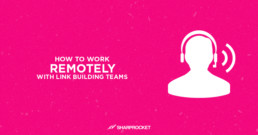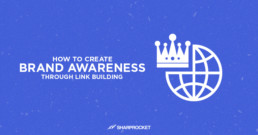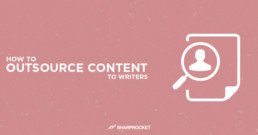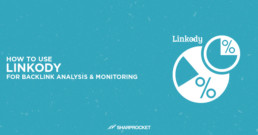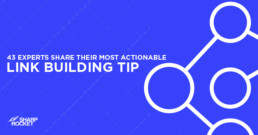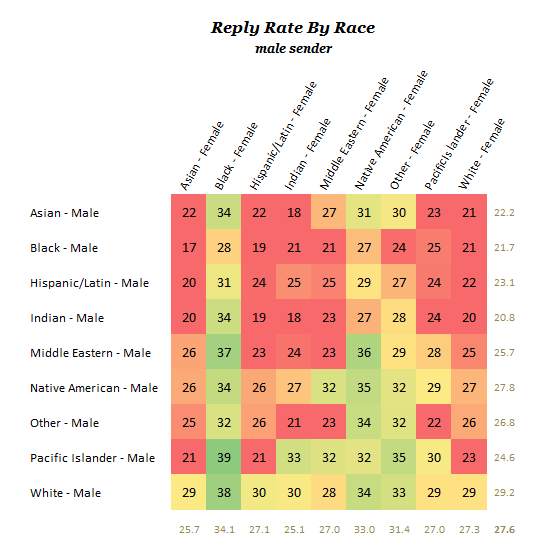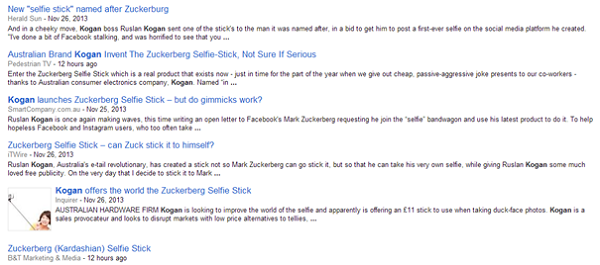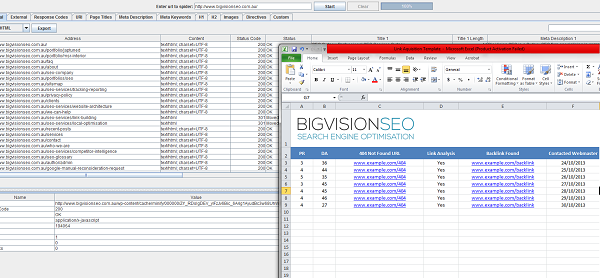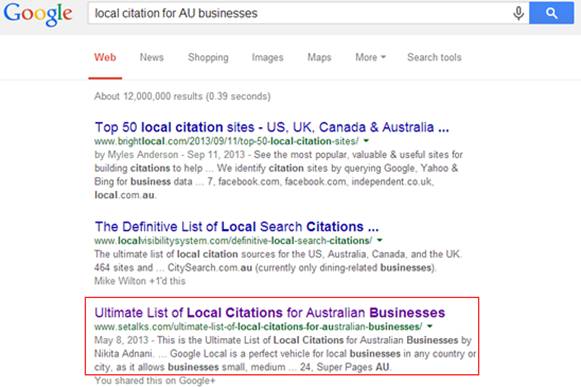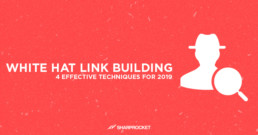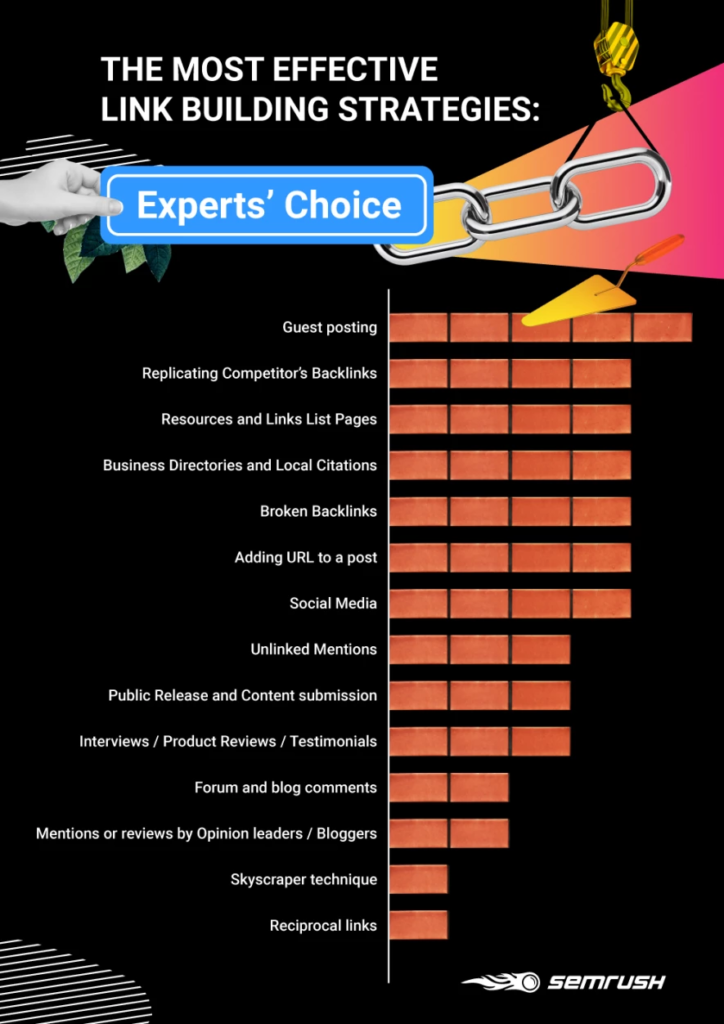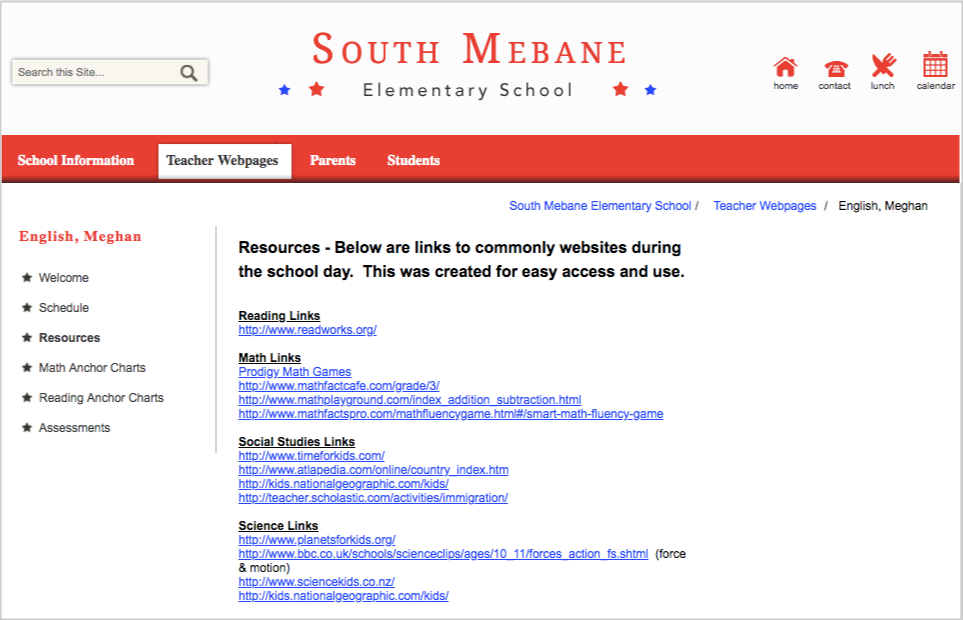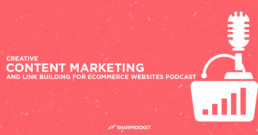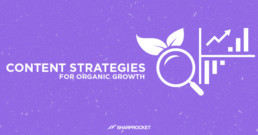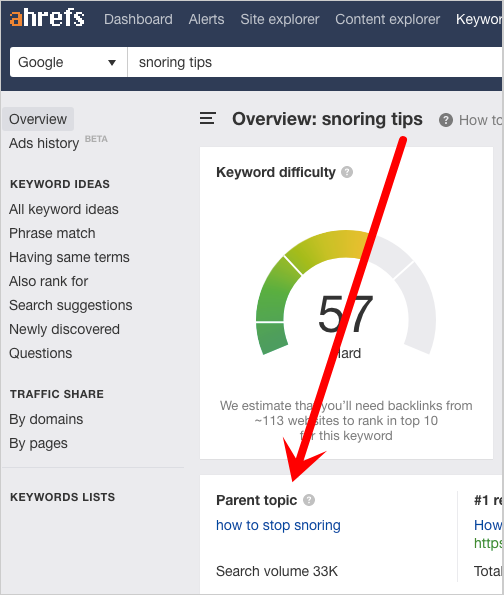How to Work Remotely With Link Building Teams
Given the Covid-19 Coronavirus crisis, many companies face new challenges in transitioning to a new work environment. While remote work setup is being practiced by many brands in outsourcing industries, a lot of adjustments still have to be made.
Working remotely is a new skill.
More particularly, if you are working with a team, it takes a little while before your team can transition smoothly to an efficient and effective system of remote work.
There are a couple of guides available to get you started with remote work. Here are some useful resources that you would find to be useful:
- A Complete Guide to Turn You Into a Pro by Paymo
- Answers to Remote-Working Challenges
- Remote Work Guides and Tips by Aleyda Solis
As a link building agency, we've transitioned to full remote work setup weeks ago (as of this writing). This brings us lessons from experiences ourselves and from observations on other SEO agencies and link building teams.
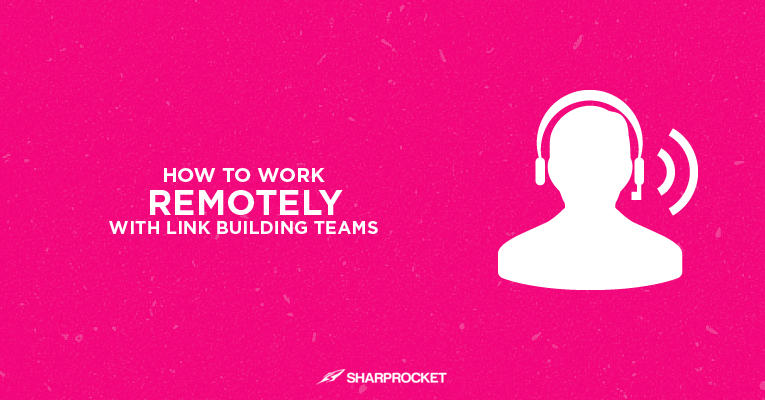
On Working Remotely
You can't have the full same format of work in office applied to work from home setup. These two are different.

For instance, communication should be more prompter than usual, as the only way to get things done is through faster feedback on tasks. Another is of usage of some software for work. Cloud-based types of software must be more often than not, be used by teams to organize projects and to designate tasks properly to members.
How to Work Remotely With Link Building Teams
This is not a comprehensive guide for working with remote teams. But rather, focus specifically on link building activities, and tips on working with link building teams to achieve link goals for clients.
1. Create performance reporting documents
In many brands, they call it as key performance metrics KPI reporting sheet or document. For content teams, that may be the number of content assets produced during a set period of time. For us, link building teams, the range number of editorial links delivered to our clients for their target pages.
It's essential to have one for your link building team. First, you get them accountable to monitor their own performance at work. Second, you measure their productivity based on the highest impact and highest flexibility of tasks they do on a daily work basis.
Have a performance reporting document set up for your team. You can get a manager to monitor and have documents ready for you or you can do it yourself.
2. Plan out your teams' daily or weekly schedules
Once you know your key performance indicators (for some, this has been identified before even transitioning to remote work), start planning your team's work schedules.
Not everyone will have the same work schedules, depending on the volume of work you have as an agency. Some teams may be skeletal, which means they get to work through batches. Batches of teams may work earlier during the week (Monday to Wednesday), while others get through the Wednesday to Friday work schedule.
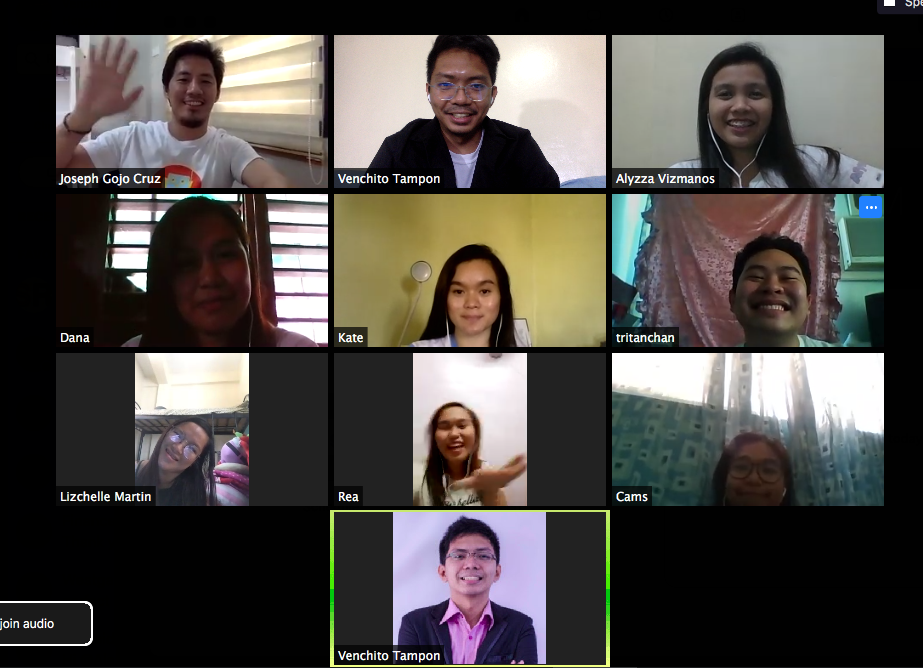
Through planning, you'll see methodologies for better work efficiencies and productivity.
Here are some tools you can use to manage work schedules and to delegate tasks effectively:
3. Conduct daily or weekly meetings
While you can't conduct in-person meetings with your team members (as what you do in-house), you can still effectively conduct online meetings with your subordinates.
Essentially, what you should be looking at here is proper schedules of 1-on-1 and team meetings without members sacrificing their time for prioritized projects and tasks.
Here are some tools that you can use to communicate and/or scheduled meetings with your team:
In communication, it's important to tell your team how and when they can reach you. There are urgent matters that have to be addressed properly, so giving your team your free schedules for interruptions help in addressing important matters quickly and thus, achieving target goals.
4. Address challenges and problems by providing solutions
There are minor and even intricacies when working with remote teams — that's not a surprise anymore. Weekly meetings with your teams and proper lookup of their current output give rise to many problems of inefficiencies and unproductivity.
You don't have to address them all at once. Identify problems that contribute negative impact on working performance and team culture. Provide solutions by asking your team for suggestions, as well as getting coaching and mentorships from other agency owners.
Here is a good webinar recently by Dev Basu of Powered by Search that addresses some challenges agencies face during a crisis:
Once you've identified challenges, the next step is to find any points of improvement.
These improvements can be implemented one by one. Then see which of them makes a significant impact to work productivity based on their expected changes in outcome.
5. Never forget training of your team members
This shouldn't be the last tip in this list of remote work recommendations. Training is ongoing essentials of an organization.
Without it, you expect plateau in growth, and could greatly affect your business' bottomline — if you're the agency owner.
Start with creating your training documents for your teams. It is best to have it available before work from home transitions. But regardless, you can spend some hours on top of your current daily work priorities to prepare them.
You can use Google Drive, Asana, Basecamp, Trello, Camtasia or Loom (for video recording) to prepare team training.
Here are some further tips to manage and develop your remote teams:
- Build morale of your team through pre-meeting conversations. Giving them encouragement and needed help to support non-work and work-related concerns.
- Get coached by agency owners who have extensive experience handling remote teams. This gives you new perspectives on things to adapt and apply to work from home functions.
- Address immediate employment concerns. Have it effectively conducted by your HR and admin team members, so you can focus on your priorities.
Further Reading:
Remote Work Made Simpler
I didn't say remote work made easy. Because it's not. However, by applying tips I've shared above, you'll be able to see increments of improvements to your remote team's productivity and work performance.
How to Create Brand Awareness Through Link Building
Brand building is the new link building.
Communicating your brand in a way that captures the attention of its target audience through quality content and community engagement.
You resist shortcuts and spammy link building tactics and focus more on thinking how your links can affect your brand value and brand equity.
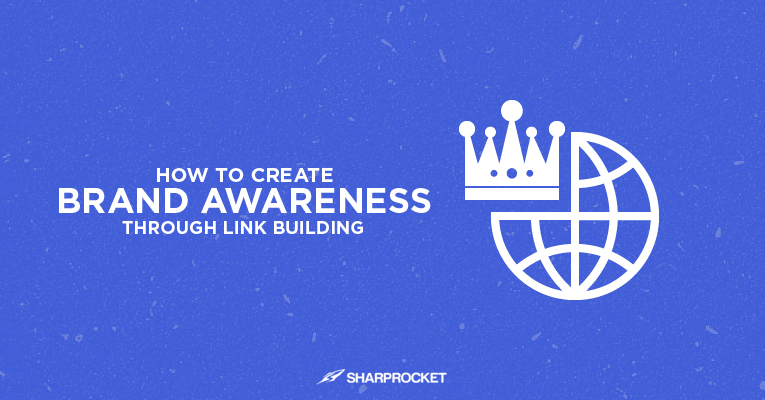
What is Brand Awareness?
Brand awareness is the extent to which consumers are familiar with the distinctive qualities or image of a particular brand of goods or services.
Strategic link acquisition starts with identifying your brand's distinctive qualities.
On unique value proposition
A unique value proposition plays an important role in how you deliver your content assets to its intended audience.
If you can discover what your brand differs from its competitors — may it be in the total brand scheme or purely for content sake, you can easily emphasize the uniqueness of your brand or your content in all of your external marketing efforts.
Given that potential linkers receive endless pitches from brands looking to get natural links from people's blogs, linkers become more aware of what makes content on a particular topic unique and valuable.
They've seen different formats and styles of content for a particular topic. They knew what makes content different from others.
When you know your content's value proposition, it would be simple for you to create brand awareness around it. As you know how to position it to people who are likely interested in sharing and linking it, as well as improve the entire content asset for better information and value.
Importance of Brand Awareness
Fosters trust
You don't participate in any engagement of a brand if you don't trust them at all.
The same is true in pursuing links through brand awareness.
When people become more aware of the caliber of your content and what your brand stands for, as far as disseminating information is a concern, you gain trust from publishers and other content creators in your space.
Positioning yourself in the market
Getting a market share in an industry, particularly if your brand is just starting out, is never easy.
There has to be a strategic approach in building the authority and positioning yourself in the market.
Link building helps your brand gain momentum, wherein organic links become easier as people are starting to recognize your content every now and then. They link to your content pieces naturally as you develop your expertise in the market. Brand awareness does that.
Develops association
In building awareness, you gain new contacts and networks you never knew in the first place.
These are brands and individuals who gained a good understanding of your brand.
The more you build brand awareness, the more you become associated with influential people in your space — which primarily helps in gaining more exposure and secondary benefits of backlinks, social shares, and brand mentions.
Resulting to brand loyalty
The law of momentum starts to kick in. As you create awareness around your brand, you earn interest from people through the quality of your products and through the value-adding information of your content marketing efforts.
When this happens, you position yourself in the market and attract customers who will repeatedly buy into what your brand offers. This results in building new sets of brand advocates — resulting now to brand loyalty.
How to Create Brand Awareness Through Link Building
1. Strengthen your brand ambassadors
People connect to individuals more than brands. Brands don't have personalities unless a person or group of people from an organization speaks up — these are brand ambassadors.
In the idea of link building, brand ambassadors are people of a brand with a high level of expertise on topics they care about.
These are people who can go out and contribute something of value to the web community — may that be in a form of content, quality conversations on niche forums and community sites, and other initiatives that engages value.
Here are some brand ambassadors you can gain inspiration from:
Tim Soulo, Ahrefs - SEO Saas

Do you have to force your CEOs or founders to be brand ambassadors?
Definitely not. There are options you can choose:
- Opt to hire a thought leader in your space who can go on behalf of your brand — this could be an industry follower with existing huge following or someone starting out in the field but has extensive work experience.
- Start looking for someone who can build credibility through content contribution internally and externally of your brand assets (e.g. blog publications). It could be you or it is someone else.
Either you choose to hire an experienced influencer or build credibility for a potential brand ambassador. You need to strengthen him or her for more effective link building results.
How to build links by strengthening your brand ambassadors:
- Use expertise to build links. Learn how to use HARO and subscribe to the platform. Choose topics your brand ambassador has expertise in. Then deliver at best by answering questions with direct answers.
- If the brand ambassador is starting out, build his or her portfolio by contributing to mid-tier publishing websites, then go all the way up to niche high-end content publications
- Develop associations by engaging with past networks of friends with an online presence. Start sending emails or sharing their content on your social profiles to send radars on their signals that you're into the same line of industry.
2. Organize or sponsor an event
Events are a great way to elevate your brand.
Organize a public event. Either you do it for your brand alone or hire subject experts in your space to speak about topics they care about. Align topics into one theme and start an event.
Glen Dimaandal, a local and international SEO speaker produced several events on his own — PeepCon and SearchWorks which have become locally known for bringing experts in the search marketing and digital marketing field.

How to build links by organizing or sponsoring events:
- Set a name for your public events to get brand recall — for your participants to quickly remember when they see your events on different web places.
- Get authority links from event syndication and distribution websites. All it needs are your event details.
- Incentivize bloggers and content creators who are participants of your events. This is to get natural event reviews and/or mentions on their blogs — when this primarily depends on the quality output of your event.
3. Maximize podcast opportunities
Podcasting is mainstream nowadays.
Any content creator in industries that I know is thinking of ways to penetrate podcasts: either to start their own podcast or become a guest.
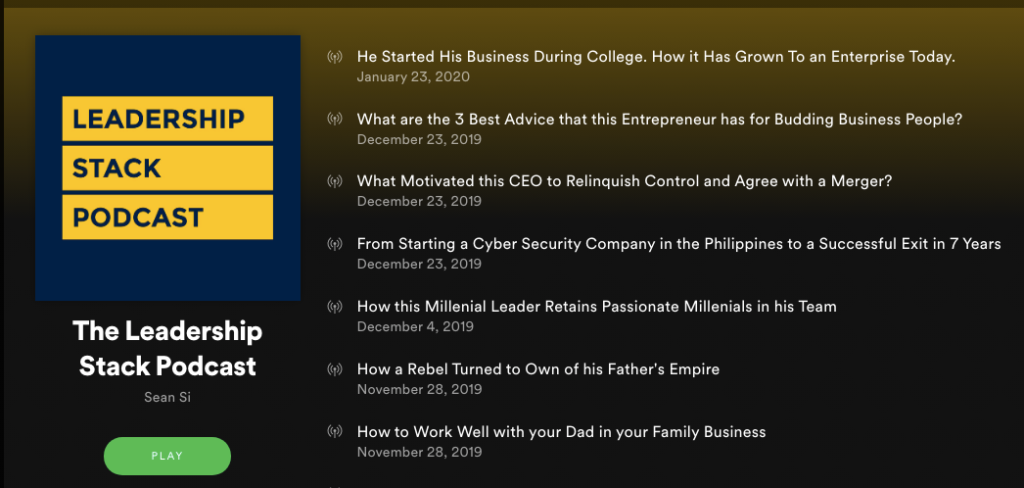
If you're trying to gain exposure by being guests on podcast shows, you can start reaching out to relevant podcasters.
I've covered the entire process of how to get podcasting link opportunities. But here are a few tips from the guide:
- Prospect for blogs hosting podcasts through discovery in iTunes search, Google search, and podcast directories.
- Organize your list with host/s name, contact details, and description of podcasts for easy customization of outreach emails.
- Choose a podcast show to pitch. Ask some assessment questions: Is this podcast providing external links to websites of guests on podcasts' footnotes or transcripts? Is the show focuses on discussing narrow or broad subject matters — is it a fitting topic to our brand? Is there a substantial number of followers on social and networks that can help us create more brand awareness after podcast guests?
- Pitch to become an interview guest. Share your portfolio and details on why you deserve a slot. Don't be too aggressive in followup emails. Here is a great post on how to send a follow-up email after no response.
Once you receive links to podcast interviews, start sharing it on your social profiles and to your email subscribers — to get a ripple effect of bringing in a new audience to podcaster's following list, while at the same, create awareness about your brand.
4. Create tools for targeted audiences
Content that creates both interactive and learning experiences gets the most editorial links, in most cases.
Tools are an example of this type of content. It helps audiences to do or to learn something specific.
A few examples of tools that work are:
- email signature generators
- privacy policy generators
- SaaS metric calculators
- blog idea generators
- invoice generators
- SEO checkers
There are so many other examples. Think of ideas by discovering problems no one in your industry has solved yet, or if there is one solution that has some features not catering to solving those problems you've discovered — you can take advantage of that.
How to build links to helpful tools:
- Start including descriptive links in your external content (e.g. guest posts) that previews your tool, if it's relevant to your post.
- Create short videos or how-to blog posts that showcase your tool. You can use Loom or Camtasia for video recording.
- Invest in community engagement by sharing a link to your tool page. You can exclusively give influencers in your industry early access to your tools. Exclusivity offers an advantage for more link opportunities.
5. Leverage influencer outreach
Start by reading why and how influencer outreach works in this guide.
Identify influencers who be will your key people of prospects for more brand awareness through link building.
How to make the most out of influencer marketing:
- Strengthen relationships with influencers, even if there are no opportunities for links. Don't let "for just links" mindset get in your head every time you connect with influencers. Adapt the "law of reciprocity" by offering too much value to a person that it helps you get residual benefits in return.
- Look for upcoming influencers as they are most receptive to press and interview requests, even product reviews.
- Categorize influencers as micro and nano influencers — you can check out this guide on how to do it.
- Collaborate content with thought leader content creators. You get the benefit of association once you do that.
- Interview influencers on your media channels (Youtube or podcast sessions). Once they share it with their networks, you create more exposure to your brand.
Think Brand Building
Think of branding when doing link building.
Always go for long-term benefits and initiate massively for building your brand. Through brand awareness, you start positioning yourself (your brand) in a way that you earn trust, respect, and tangible benefits, such as links and social shares.
How to Outsource Content to Writers
Outsourcing content to writers is never easy.
Though you can simply post a job ad and onboard a writer instantly, you won't guarantee success in your hiring just like that.
Make it a hurry to hire content writers and you lose money and time in business. It is better to follow a specific process to get qualified content creators that can help scale content marketing for your website.
Before I discuss the steps to outsourcing content to writers, let's understand the benefits of doing it.
Benefits of Outsourcing Content to Writers
Scalability
I'll be speaking on behalf of an agency that is churning out hundreds of content for our clients through our content marketing and link building services.
Doing so requires a lot of work.
Outsourcing content writing to credible writers frees up the time to write content work itself which allows us to focus on other sides of the business.
The same can be true for you. Outsourcing is done to free the legwork out of you and reduce the time spent on long-term content (time-consuming) creation itself.
That's not to say you don't get involved in the process. But with two or three people working with you, you can be scalable in content creation in a very timely manner.
When content creation is covered, your team (people who are involved in content marketing) can spend a lot of time promoting content assets.
Given that this is where most brands get caught up, they keep producing content assets on their blogs without even promoting them massively on target audience websites.
This shouldn't be the case. Create content and promote it so you can get the results you desire for your campaign.
Leverage other people's expertise
As I covered in my guide on creating linkable assets, you have three options in content production:
- Do it yourself or with your team
- Hire freelance writers
- Look for industry practitioners who can write about your preferred topics
In hiring freelance content writers, you can vouch for the last option.
They may not be easy to find, but if you find one or two, you can expect a better quality of writing for your blog.
There are many other benefits of hiring freelancers for outsourcing content creation, but let me go straight to the steps on how you can outsource content to writers.
How to Outsource Content to Writers
Step 1: Decide on the type of content writer to hire
You can either hire a freelance writer with a generic background in your industry or hire an industry practitioner who does freelance work.

Your basis here is the type and format of content you are eager to create.
Are you looking for content backed up with research and case studies? How about someone who can walk through readers with a step-by-step process on achieving a goal or a review on using an industry tool? Those things certainly require someone who is a practitioner in your field.
Even the brand voice and style of writing depend on your current content strategy (if you have one). Are your writings more conversational in nature or it is purely academic?
Those matters will help you decide on the type of content writer that suits your needs.
Step 2: Look for credible content writers
Don't just find any writers who write pieces of content. Filter out any blog post creators who don't have any experience in technical writing about your industry topics.
You want to ensure good quality in your content produced by people you're looking to hire.
The question here is where to discover content outsourcing writers.
Referrals
Start asking your networks if they know a freelance writer who can write for your brand.

Potential writers vouched by people you know are good recommendations.
Your contact/s can speak about the credibility of writers they've worked with (or know). You could also ask them about the writer's writing output, communication style, and other pertinent matters you think are worthy to consider.
Besides referrals, you can opt to post job ads on top freelancing websites.
Freelancing websites
Here are top freelancing websites where you can post your job ad:
- UpWork
- PeoplePerHour.com
- Guru.com
- Problogger Job Board
- BlogExpose.com
- BloggingPro.com
- FreelanceWritersDen.com
There are of course other freelancing platforms or websites specific to freelance writers, but the ones I've mentioned above are the best places to start your prospecting.
When posting job ads, it is best to use any applicant filtering techniques.
One that I recommend the most is adding lines to your job description, such as using "bacon" or "breakfast" in your subject line or any words or phrases variable to your job description.
You'll find that this is an effective way to weed out applicants who don't have attention to detail.
In addition, you can see applicants who are very creative in their applications. Instead of just putting "bacon" or "breakfast" in the subject line like "bacon content writer position", they write creative subject lines such as "Baron & SharpRocket team eat bacon for breakfast win".
Step 3: Assess your writers through tests
There are several factors to consider when choosing the best freelance writer for your site, but here are the top ones we always check.
Request sample work
At most, you'll find writers who have sample works ready to submit to employers.
While I don't judge quickly, in our experience, the quality of sample kind of content isn't always the same as the actual writing once you hire them.
It is best to get them to write a paid sample work. If you are involved in the content ideation process, you can send a list of specific topic good ideas they can choose from and create content.
There are two advantages of doing so: you get content that you can publish on your blog (if it fits your quality preference) and you get to see the actual work for the writer.
That is why it's important to choose the top one or three freelance writers you really vouch for from your prospecting strategies, so you don't have to pay a huge amount just for samples of work.
Compare rates per article
Communicate to your top prospective writers on their rate per article. This is a good basis when choosing which one fits your budget. You can ultimately hire the person as an in-house great writer if it's a better option for cost preference.
Know their payment preference
This is another factor that other articles on outsourcing content writers don't include.
While there are payment options available like Paypal, Payoneer, or international transfer wires, remember that freelance writers from other countries may not have the same payment option you prefer.
Get that matter discussed earlier when assessing a potential content writer.
Communication
Whether you communicate with the writer through email or on freelancing platforms, you'll get a sense of the response time of the writer.
This is crucial in the onboarding and content creation work, as you don't want delays to happen with your content.
Step 4: Hire your preferred content writer
Once you assess content writers and hire the right one for you, have a proper onboarding process.
These are some matters you have to brainstorm and finalize:
- Overview of your company (and the style and process of sharing it with your newly hired content writer).
- The flow of the content creation process (from content ideation to publishing)
- Turnaround time for each phase of the content creation process
- Payment preference and system
For the last part, it would be easier if you have a payment preference for content writers. Whether you choose an upfront payment option (half of the cost is paid before the writer starts writing the content) or full payment upon completion of work.
Step 5: Create a workflow for the content creation process
The process is key to scaling your content marketing campaign.
Without the proper workflow, there will be miscommunication between you and your content writers. It's important that they understand well the importance of each phase and how well each phase is integrated into one another.
One thing you don't want to miss here is the discussion of the turnaround time per content. Each content depending on the type, length, and subject matter has a specific range of days to get finished.
Start brainstorming (with your team) of a good content creation workflow dedicated to freelance content writers.
Step 6: Build stronger relationships with content writers
Employ empathy when dealing with freelance writers. Their creative professional side may be affected by many different factors that don’t involve work.
A quality 1-on-1 meeting with each of your content writers once every week is good enough to establish strong relationships with them.
When people are being taken care of, being appreciated by their employers or agency partners, they can do better at work. And therefore, it helps you in the process of producing the highest quality output of content that you desire for your website.
Final thoughts
Outsourcing writers with your content creation needs doesn't have to be complicated.
You can do it effectively with proper planning and execution. I hope the above step-by-step process gives you a head start to hiring freelance writers that produce great content assets for your brand.
Applied Attraction Marketing to Link Building
Without content, it's tough to build links.
Content ties the interest of the linker and your brand.
The content that has the highest value proposition to the end-user proves to get the right types of links.
Well, you can use content in two ways.
Reach out to a potential linker and offer your content as your value proposition. Your content matches the needs of their blog audience and in return you get a link. Success.
Or, create content that attracts links over time. Manual outreach is part of it, but because the content consistently attracts potential linkers, link building becomes almost automated.
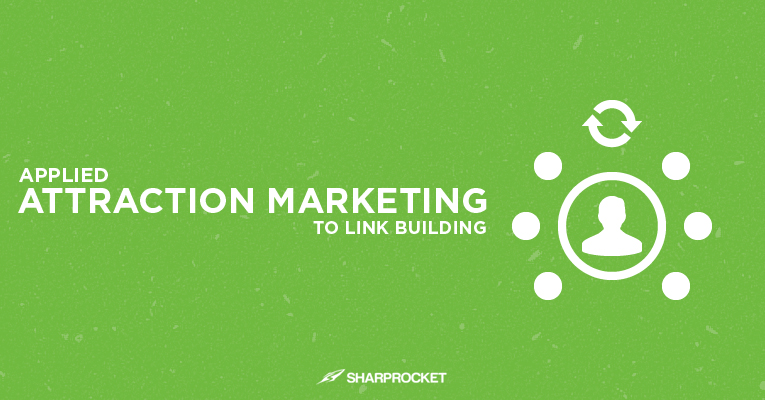
Attraction Marketing
We'll focus on the second — attraction marketing.
Attraction marketing is the process of drawing interest to a company, product or service using carefully devised techniques. The goal is to attract potential customers to the way the item has bettered the seller's own life.
When you focus your efforts on executing a strategy that attracts link opportunities for you, you get the most leverage.
While you can't choose which page links to you naturally, you can expect a consistent link growth for your pages with a link-attracted content strategy.
On Building Assets That Attract Links
Content assets must have its intended purpose. Creating content assets for the sake of fulfilling your editorial calendar is useless.
There is economics in a content-based link building environment we all have to consider. Links, as the main primary goal for an informational page, can have a secondary effect and value to the bottom line surface of the brand.
The right types of links will get your content to increase its search visibility for target keywords by making it rank better. But an additional secondary value to that is if those links can push further the secondary effects to the brand.
Attraction-driven links have high relevance standpoint
The right type of content attracts the right type of links.
When you compare links driven through manual outreach and links naturally acquired through ranking content for search, you can see different patterns of decisions.
For example, in manual outreach links, you can decide what websites or blogs to do outreach to.
From a relevance standpoint, if a team of link builders doesn't understand the relevance of links at its core, you run the risk of getting not-so topically relevant backlinks for your webpages.
Links attracted in any form have a higher assurance for relevance particularly from publishers who perceive your content worthy of reference. Content creators can be assumed to link only to sites and pages that are relevant to the information they're creating content about.
In general, links with more attraction marketing intent can have relevant links acquired that fit three important link factors: relevance, trust, and authority.
Links attracted push referral growth
Relevant links are likely to get clicks from its referring pages especially if those links drive click intent, such in the case for referential links. It gives an additional desire for the reader to look for more information.
If a content asset that ranks for search gets referential links from publishers, there is a likelihood of referral growth.
Given that those referential links can drive referral visits to their referring pages (your pages), you increase the odds of more content creators in your industry vying for more references. Chances are you multiply referral visits to your content pieces when you get more of this type of link.
Links attracted increases content's search visibility
With an initial solid manual outreach to get links to content, that page can rank for its target keyphrase. If keyphrase is referential in nature, when it ranks, it attracts more eyeballs from publishers who consistently discover updated and latest pages to cite on their own content works.
Attracted links can be turned into meaningful relationships
The law of reciprocity states a mutual exchange of value.
When you've been given a link by a publisher, there is an inherent desire to give something in return. While it may not necessarily be a backlink as well, you could perhaps send an email message with a thank you note in it.
Given that those recipients are actually the ones who link to in the first place, there is a built-in connection to respond to your email.
A subtle message for people who naturally link to your brand can lead to meaningful relationships, which then leads to more in-content links in the future.
Attraction Marketing Applied to Linkable Content Creation
When you build content pieces for link attraction, you think an end-to-end process.
From topic research to content's organic link acquisition activity, you ensure every step is tied into every other step.
A well-thought initiative for topic research, for example, should perceive the right audience for outreach, when it's content promotion time.
Every activity in the way must be well coordinated to ensure a much larger success in the campaign's end results.
A. Find referential topics or source-to-cite queries
Content strategy starts with ideation or getting blog post ideas.
Generating content topics for a specific purpose is vital to the success of the content marketing campaign.
For an attraction marketing-driven campaign, you want to find topics that have a chance to earn links from publishers.
These are normally referential topics or source-to-cite queries.
Content creators refer to valuable pages by citing them on their blogs.
Before diving into topic research, it's important to understand why people are actually searching for (even linking to certain pages) for additional references.
1. The difficulty of defining, describing, and explaining the topic
Is there a demand for the keyphrase to come back again for another time and search for that same keyphrase again?
Think about it. If a content creator wants to know what this jargon means because it's difficult to explain it in layman’s term and may require definition from a credible author, it has a chance to be included in another content piece by directly linking to the source page.
This is an initiative of content linking to the definition of a technical term as it gives the entire overview of what the phrase means.
While you might be aggressive about this and try to create your own definition of every technical term and publish them on your site, it's important to understand the difficulty as well as the demand for the keyphrase.
Other examples are concepts that can't be published by non-practitioners. Any new industry concepts require technical expertise to explain it clearly to its intended users.
IIf your brand can simplify a concept to be better consumed by its target audience, this makes the topic feasible to attract potential link opportunities from publishers.
2. Ease or convenience
For basic applications that demand more attention and time to create is an opportunity for content creators diving in the attraction marketing idea.
Here are some examples of the type of content that aids people to create content for personal purposes:
Rental Income Expenses Template (SPREADSHEETS)
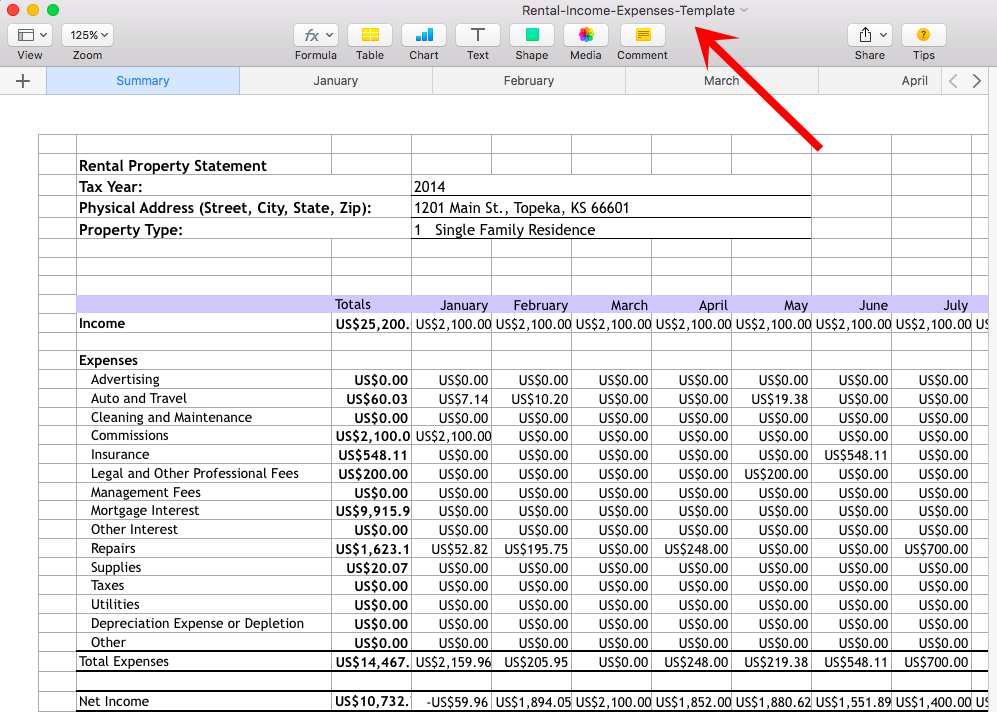
MBA Recommendation Template (RECOMMENDATIONS)
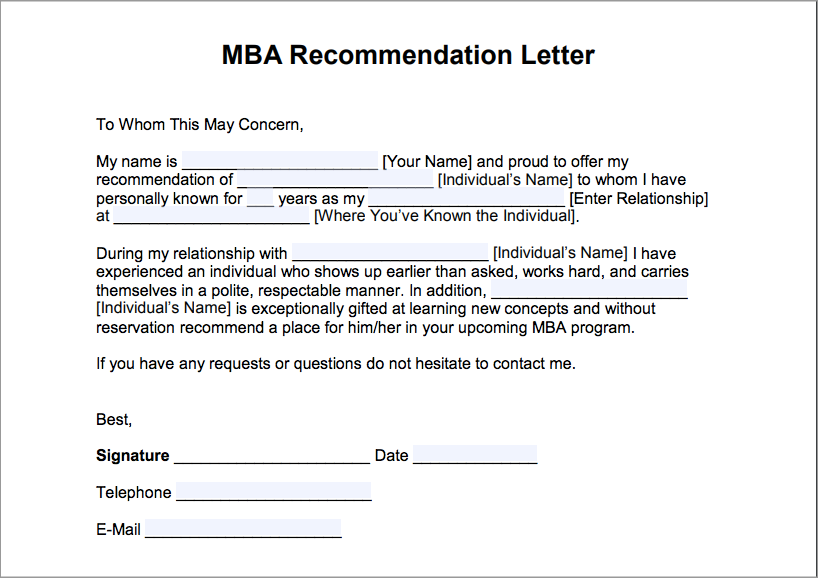
Other types of templates:
- letter template
- estimate template
- proposal template
Most of this type of content would be more useful if they can be customized immediately. PDF forms uploaded to websites require more friction as it needs to be converted to an editable file format.
Regardless, sample content pieces with editable sections are topics to consider for an attraction-driven linkable content.
3. Additional credibility for content
Referencing valid external sources increases the credibility of the content.
Topics of a survey, data, numbers, and statistics have high possibilities of linking as they are deemed necessary to make a content piece updated, relatable, and credible.
Finding Source-to-Cite Queries
Look for any queries that fulfill the aforementioned needs:
- the difficulty of defining, describing, or explaining a topic
- ease or convenience
- additional credibility for the content
Discover any of these source-to-cite queries in your industry:
- statistics
- data
- template
- letter
- sample

It is best to look at the current linking patterns of the top-ranking pages for your preferred queries. Here are things you have to consider:
- The average number of unique referring domains of currently ranking pages for the query
- Type of links (citable, branded, etc..)
- Link placement
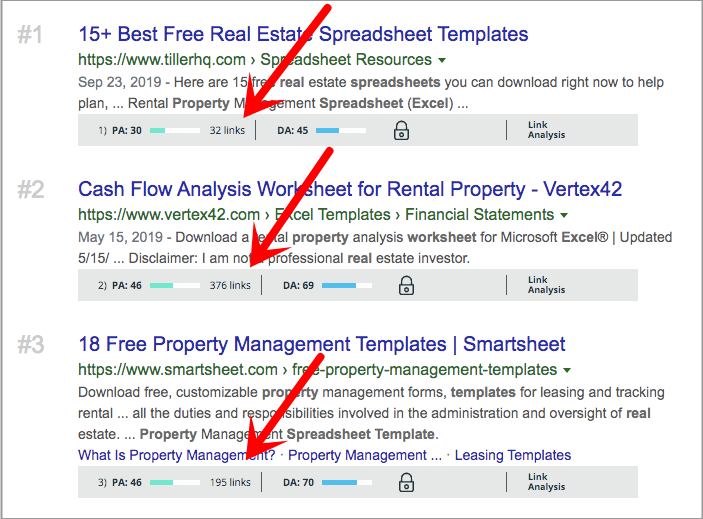
By having those considerations, you can then estimate a good number of links to expect when the content ranks for the query.
B. Use manual outreach to acquire initial links to rank for those queries
The competition of the search for the key phrase matters whether you can easily rank for it or not.
If it happens that the keyword difficulty is too high and the ranking pages have more than 50 or 100 links attached to them individually, it will require a massive outreach campaign to even get the page 2 or 3 ranking spot. That's the reason why it's important to study the topic of competition. The question you need to ask, "does my site have enough authority for my new page to rank for the query?"
That being said, investing your efforts into initial manual outreach is needed to get the initial backlinks to rank for source-to-cite queries.
From the Future agency recently launch a useful tool that can semi-automate the promotion process of a content piece.
It solves that one overlooked simple strategy in content promotion — which is basically reaching out to all brands, sites, and publishers you've mentioned on your page.
Given that, if you can reach out to these mentioned content creators, there is a reciprocal benefit you can gain in terms of a link, mention, or social share of your content piece.
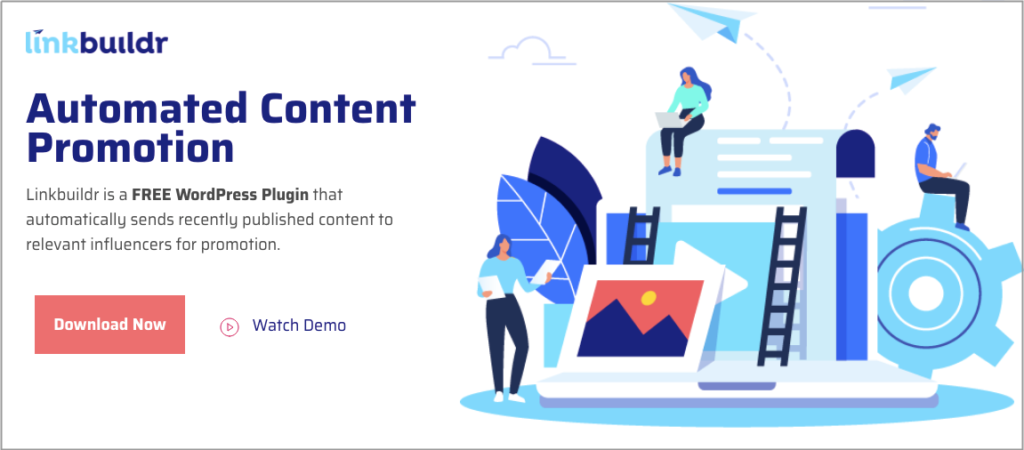
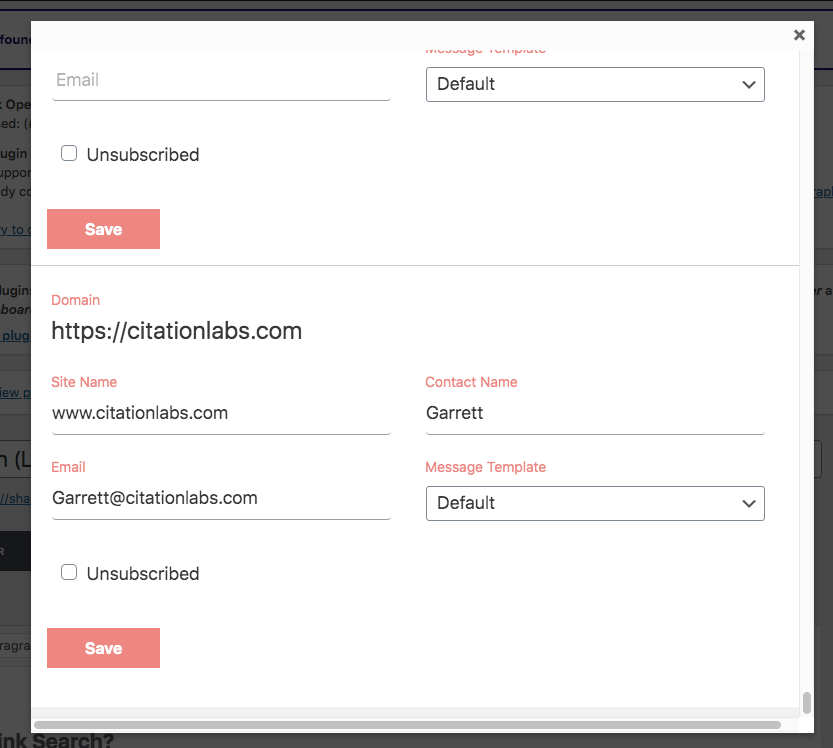
You can also reach out to publishers who've linked to content assets similar to yours. Discover those linking pages using Ahrefs in two ways:
- Use Backlink Explorer to find all pages linking to a similar content
- Use Content Explorer to find highly related pages and discover links to them
The leverage to push the content to dominate the first spots for a source-to-cite query is certainly difficult.
Your results depend on the quality of your content and the relevance of your link prospects to your page.
The moment the page dominates the top spots for the query, you can expect links from people who've used your content as a reference to their online works. The more links you get from this almost automate the process of link acquisition, the higher it'll climb to the top of the search.
C. Use optional paid advertising to build more momentum
Another way to build up the content higher in rankings is to spend a minimal amount of money on advertising (~$100).
There are two advertising options you can use: pay-per-click and Quora.
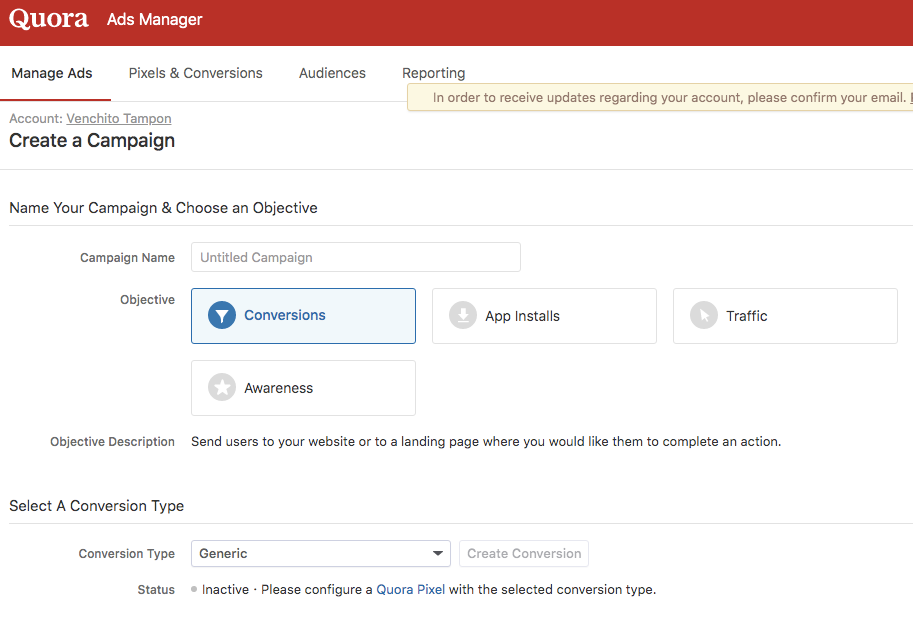
Depending on the cost per click for the query (for PPC) and the number of possible visits from Quora, you put more eyeballs to your web asset, which then leads to an increase in search visibility for the query.
Google paid advertising also gives you the leverage to first be seen when people search for the query. This means they have more chances of consuming and eventually including in their publishing initiatives.
D. Use Aware or Ahrefs to monitor links and mentions
Use tracking tools to monitor any new links to your source-to-cite content piece. By doing so, you can check the advertising spent or the return on efforts you gain from doing the initial manual outreach.
There are secondary effects you might miss out if you focus alone on bare link metrics. Try to monitor or at least look at the next set of links after you rank for the query as well as the relationships you've built or might have built during the process of content promotion.
Build Momentum in Attraction Marketing
One attraction marketing method is to let people come to you because they've known your brand.
While that's easy to say, it's not a reality for many brands online. Some of them must build the initial momentum to get the initial visibility in order to attract people they expect to have for their website - whether those are link opportunities or branding and relationship networks that can scale the online business.
Whatever it is, build momentum first, then leverage on what words for content promotion, and start seeing results from both branding and link perspectives.
How to Use Linkody For Backlink Analysis and Monitoring
In my years of experience, I would say that there isn't a one-stop-shop of tools for SEOs and link builders.
Using a variety of tools for many link building tasks, for example, depends on what makes each tool more suited for a specific function.
Since checking of new and existing links that have become part of our daily tasks as a link building agency, we know of one tool that makes backlink monitoring and backlink analysis made simple.
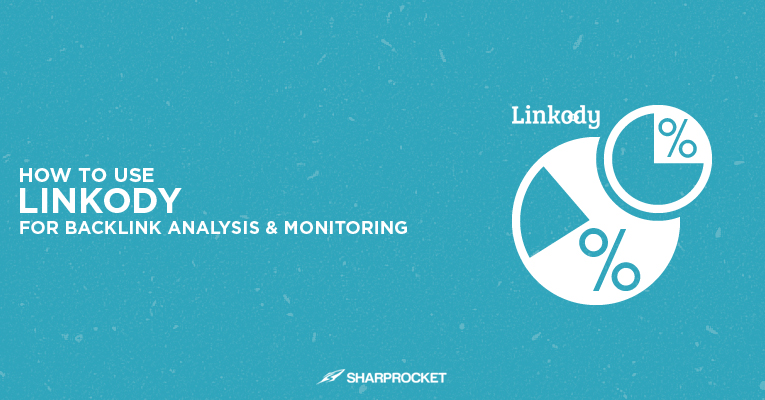
What is Linkody?
Linkody is a SaaS tool for backlink monitoring, analysis, and reporting. Since 2011, many marketers and SEOs have used the tool to monitor their websites' backlinks and even their competitors' backlinks. Simply plug in the domains of your site and your competitors and you can immediately check for all the backlinks with their corresponding metrics. The tool has the ability to run the reports for you — an ease if you've got multiple clients working with.
How Does Linkody Works?
Once you sign to Linkody, you can add your domain and your competitors' domains for analysis.
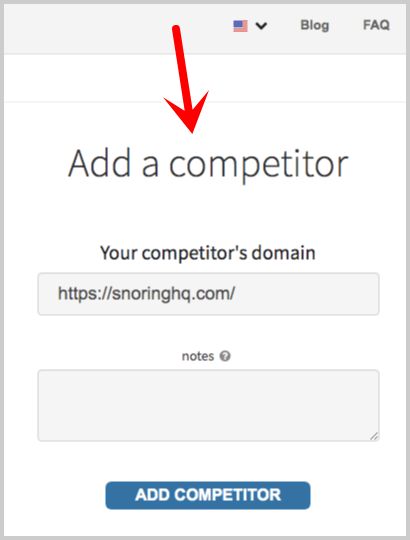 What I liked about Linkody is its ability to integrate with other tools such as Ahrefs. This gives the platform the capacity to get an appropriate metric for each backlink.
What I liked about Linkody is its ability to integrate with other tools such as Ahrefs. This gives the platform the capacity to get an appropriate metric for each backlink.
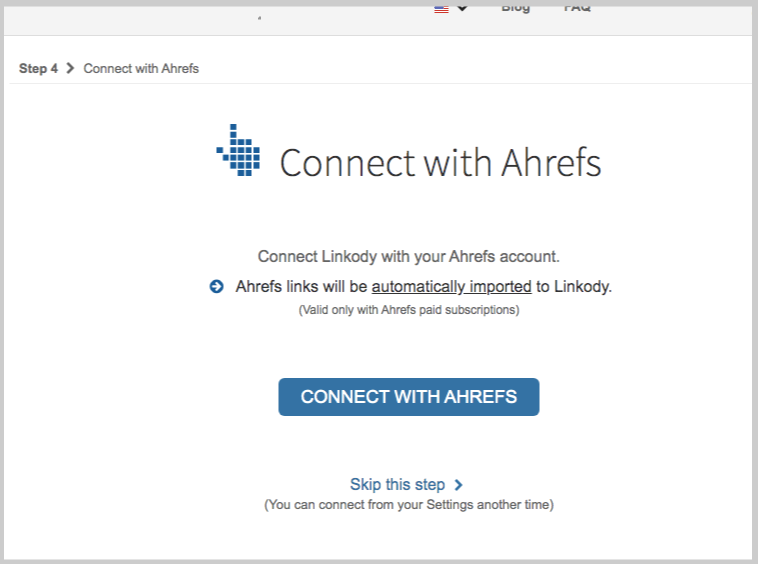
I'll be using a free account to see what the tool gives through its features.
Analyze backlinks with metrics
When you click on 'Links', it supplies with a list of all the backlinks of your site.
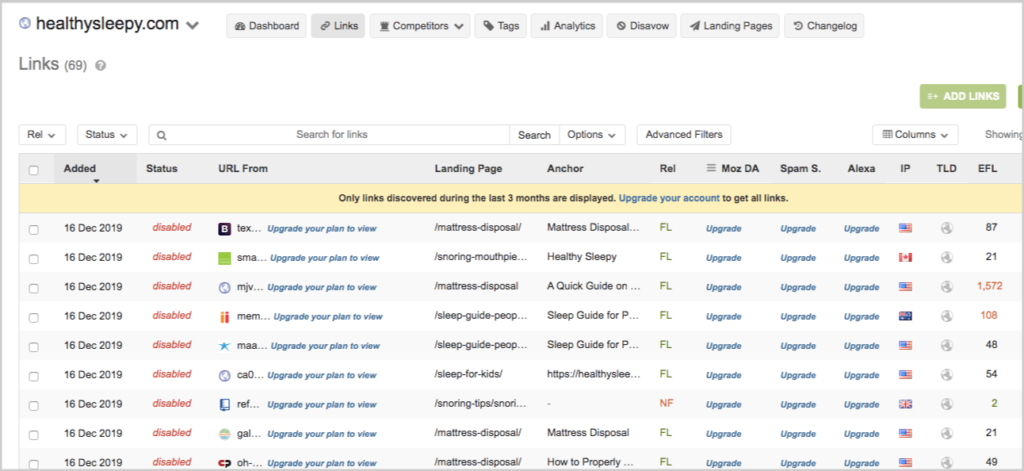
Now, Linkody only gives 3 months of data of all links if you're a free account. If you wish for an extension of let's say 6 months or 1 year, it would you to upgrade your account.
That being said, you can have details you need for links including:
- Exact URL of the link
- Landing page (page linked to by the backlink)
- Anchor text
- The date which links was discovered
- No-follow or dofollow
- Moz DA, Spam Score
- TLD and IP
Like any other tool, there are advanced filters that you can use to only include links that meet certain criteria (last live from 1 month ago).

Landing page error is a quick feature to find out any landing pages of your site (where links are pointed to). You may create another page of the site and redirect that landing page error URL. Build new links to the new landing page.

You may also want to use tags for quick filtering in the future. You can add tags for type of backlink (comment, round-up, guest post, etc…), sites/domains you've reached out matching your existing list of outreach prospects, and other important filtering analysis for both link search and outreach initiatives.
Track and monitor backlinks 24/7
Performing many SEO tasks is crucial to a marketer. That said, one should find ways to automate significant reports and data.
Linkody notifies you of any new backlinks acquired by your site and any lost backlinks. This allows you to give updates on the progress of your link building campaign.
As a link building agency, that progress report of new links matters to SEOs as you can assess the time duration (days or weeks) it takes you to get a single link from the time you've started your blogger outreach campaign.
Giving alerts also helps in making tweaks of your content according to what specific linkers are receptive to. Either you'll add additional content formats to serve the linkable audience better or make more of the same content format that appeals to the link market.
From given reports, you can get insights and make decisions to further develop your content and achieve more success in general for your link building campaign.
Get insights from competitors' backlinks
Competitor backlink research is an essential SEO task, which gives you an overview of your linkable audience market and valuable insights to your current and next set of actions in terms of content creation and outreach.
Linkody allows provision for backlinks reports for your competitors' domains. Details of your site's backlinks (metrics, landing page, anchor text, etc..) are also the same thing Linkody offers for your competitors' backlinks.

Given the list of links are sorted from the recent date the link was discovered (December 17, 2019 - since the time of this writing), you can learn insights as to the latest link building campaign your competitors are doing.
Those latest links could inform you of the type of relationships your competitor has built with its linkers — which will then provide additional insight as to the link acquisition strategy used.
For instance, if you've seen multiple links from the same website on high-quality guest articles, that itself forms a regular column for guest posting which you can tap as a guest blogging opportunity.
Identify low-value backlinks
In our guide about bad links, we've shared how to determine if a link is good or bad. Here are some of our considering factors:
- Contextual relevance
- Traffic
- Traffic location
- Link placement
- Anchor text distribution
- Metrics
You can have a few of those factors checked through Linkody (anchor text, metrics, etc…). By doing so, you can make a decision about which kinds of backlinks to avoid in your future link endeavors.
Link Analysis Made Simple
While there are a lot more features needed to add to Linkody, its free access offers many considerations and insights where you can take action for the full development of your link building campaign.
Link analysis isn't easy but can be made simple by gathering data, filtering what's needed, and taking insights into action plans. Isn't it what continuous improvement for a campaign is all about?
43 Experts Share Their Most Actionable Link Building Tip
Link building is one of the essential and time-consuming activities in search marketing. It can help websites lift up their rankings in search results and can also enable brands to reach their business-related goals (i.e. increasing conversions through referral visits).
The approaches used in link building to target those goals vary depending on the type of industry the business belongs, the level of competition in the space, available resources that can be used by the online marketing team, and many other factors that can affect the success of a specific link building campaign.
To help us perform better in our link building tasks, here are the 43 link building experts who'll share to us their most actionable link building tips.
Link Building Tips from Top Link Building Experts
Experts have a lot of experience in the link building arena. Their mistakes and learnings would give us insights on how we can improve our link building campaigns. So let’s hear from them...
Here is the question that I sent to 43 link building experts.
“What is your most actionable link building tip?”
And below are their answers…
TL;DR
- Create Something Fun And Be Consistent
- Leverage Competitive Brand Mentions/Links
- Stop Reading About Link Building and Start Doing It
- Use Visual Assets to Build Links
- Build Links to Improve Domain Authority
- Look At The Engagement and Build the Right Relationship
- Seek More Linking Opportunities
- Create A Crazy Product
- Compare Backlink Data of Top Competitors With Your Own
- Get Testimonial Links
- Remain Compliant With Search Quality Guidelines
- Improve The Strategies You’ve Used In The Past
- Create Quality Evergreen Content
- Use Google Image Reverse Search for Image Link Buiding
- Use Preciprocation To Your Link Building Campaign
- Use New Products/Services/Features to Create A Healthy Link Profile
- Create Stuff That Will Resonate To Your Audience
- Build Relationships With Bloggers Through Guest Blogging
- Personalize Outreach Emails To Generic Email Addresses
- Go and Make Your Website A Great Experience
- Always Implement Strategic Planning In Your Link Building Campaign
- Get Links With Partnerships
- Don’t Ignore Broken Link Building and Link Reclamation
- Do a Groupon
- Take Advantage of Missing Image Attribution
- Cause Friction in your Market Place
- Link Out Generously
- Participate in Forums
- Reach Out to the Right People, About the Right Content
Create Something Fun And Be Consistent - Chris Dyson
With Hit Reach, we have been trying out lots of new ways to create content that will gain links naturally to our site. A lot of businesses I have worked with in the past are afraid to create content that's a little outside the box and does not fit within their corporate brand message, sadly 99.9999% of people on the internet couldn't care about your stuffy brand image and want to link to photos of cats or something fun.
Our biggest experiment of the past few months was to create some comic strips based around a fake digital agency "Digital Rockstars", at first it was difficult to come up with ideas but now they take very little effort to come up with as we produce them week in week out. The comics are released under a Creative Commons Attribution license so anyone can use them - all we ask for is that you credit us as the source.
So far we have published ~24 comics and earned links from places such as Ahrefs, Search Engine Land and various other marketing blogs with no outreach, except for sharing the new comics on social media.
According to Ahrefs, we have 130+ links to these comics...
I'm sure if I checked image raider or Google image search I would find a bunch of other sites who haven't linked and used our comics.
Initially, we only produced one comic per week but we're now publishing 2 comics per week due to the increasing popularity.
In 2014 we plan to create more topical comics relating to changes in the digital industry and hopefully re-purpose these comics into presentations at conferences and guest posts.
Leverage Competitive Brand Mentions/Links - Rand Fishkin, Sparktoro
The combination that I find most actionable and immediate for link building right now is leveraging competitive brand mentions/links and mentions of your own brand that haven't linked. I know it's self-serving, but for both of these, I love Fresh Web Explorer right now. I can do a query like this: "rand fishkin" -rd:moz.com and see a list of pages that have mentioned me, but failed to link to my site. Contacting them an asking for attribution is a great way to get a lot of high quality, editorial links.
Stop Reading About Link Building and Start Doing It - Nick Leroy
My most actionable link building tip is to stop reading about building links and to start DOING it. Reach out to bloggers/resources in your industry. Offer your time, resources or in some situations money to secure the best links in your industry. Also, make sure to pick up the "easy" links by scouring your competitors' backlinks. Get as many of the links that they have and then build even more!
Use Visual Assets to Build Links - Gregory Ciotti, Sparring Mind
Frankly, I'm in full agreement that 'visual assets' are the way to go with link building today. I've used animated video, such as my Science of Productivity video collaboration (1.2 million views) to build hundreds of links, and I've seen the same effect with other more static visual elements. The reason being, infographics take up a full post if someone wants to re-post it, but a small chart or illustration can be included in a longer piece to strengthen the author's point. I've seen the charts from places like the OKCupid blog passed around to literally thousands of people (via other blog posts and communities like Reddit). Think of opportunities to show people instead of telling people, and you'll be on your way to creating an image that's bound to get passed around. As an example, here was a highly controversial (and extremely popular) image from OKCupid on how your race affected your average response rate on their online dating platform:
Imagine trying to disperse that information with words alone: it wouldn't have worked nearly as well. That is where the power of visual assets lies, you needn't rely on a gaudy infographic to enhance a piece of information that people are likely to share.
Build Links to Improve Domain Authority - Jason Acidre, Avaris
"Instead of just giving you one actionable link building tip, I’ll share 22 (plus one) tips that our team has learned this past couple of years doing intensive link development campaigns.
These tips were originally published as a blog post here, but I thought of transforming the post into a slide deck to make it easier for the readers of this possibly gigantic crowdsourced post.
Look At The Engagement and Build the Right Relationship - Peter Attia
This question varies depending on the industry and its needs, but one that I’ve found to be pretty universal is to find a community to be a part of. I don’t necessarily agree with the whole “Build relationships, not links” movement, as it’s more about building the “right" relationship. For example, if you do a co-op post with someone who’s a leader in their industry, you’ll get noticed by thousands of people who are part of their community. This will give you the opportunity to get way more links, as it also gains your trust. People who see an industry leader trusts you, are more likely to trust you themselves.
I think that’s important to keep in mind when looking for new blogs to build links to as well. Instead of making sure your link is put on a site with a certain MozRank or a minimum number of backlinks, look at the engagement. A blog that gets a hundred comments on every post has more potential than a blog with good backlink stats. There’s a chance to build new relationships, get real conversions, build your brand awareness, and show real engagement through social media.
Plus, a blog with a large audience will likely get better stats in the near future. It’s always easier to get a link on a blog before they realize how valuable they actually are. And again, if you’re part of a popular community early on, you’ll instantly be trusted by any newcomers to that community.
Seek more linking opportunities - Venchito Tampon, SharpRocket
The most common scenario when doing link building is to find a page that is primarily targeting the goal of the campaign. For instance, you have a great resource on your site (e.g. ultimate guide to...) and you want to build several links to it. Usually, you will use the advanced search operators to find resource pages that are linking out the same type of content that you have (resource type). Then use the Link Miner to find broken links on the page and list down any defunct link in the spreadsheet (if you see one).
And it ends there...
Now, you have to take another route. Instead of only aiming for one link (link from the resource page), you may also want to seek for more linking opportunities from the site. Visit its blog section. Determine if the webmaster provides guest posting opportunity to its community (simply using this advanced query: site:domain.com "guest post" OR "write for us"). Check also if the site has a sponsorship page with external links to sponsors' websites. If you have a small budget for this, you might want to contact the webmaster and sponsor a physical product or money instead.
Why this strategy works?
- The more you see linking opportunities from one website, the more you engage with the webmaster. The higher the engagement, the stronger is the relationship that you build with the person.
- It semi-automates your content promotion activity. Given that you've built strong relationships with a few people, they can easily help you market your brand/content (this is good especially if they have a large number of social followers and/or brand advocates).
- Followers of your prospect site can remember your brand (since your content is always being linked out to by the site owner).
Link building should be strategic in any way. You have to be creative when seeking for more linking opportunities from one website.
Create A Crazy Product - James Norquay, Prosperity Media
To gain great links in today’s market you need to be creative. At the end of the day, it is not just about links you also need to think about brand mentions, traffic, and sales. One of the most actionable ways you can build links to a website is by creating a buzz with your brand by selling a silly product. It can be real or fake with the idea of building links in mind. One brand which does this VERY well is an Australian brand called Kogan.
In the last week, Kogan launched a new product called “The ZukerbergSelfie Stick” see product below (you can actually buy this product)
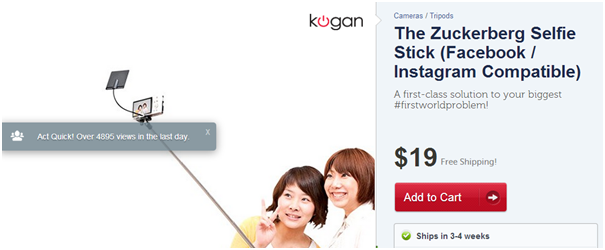
The interesting thing about this product is that big news websites have picked it up and most have linked back to the brand website or product page. In total around 26 news websites have linked back.
Example of links they have gained from this product launch:
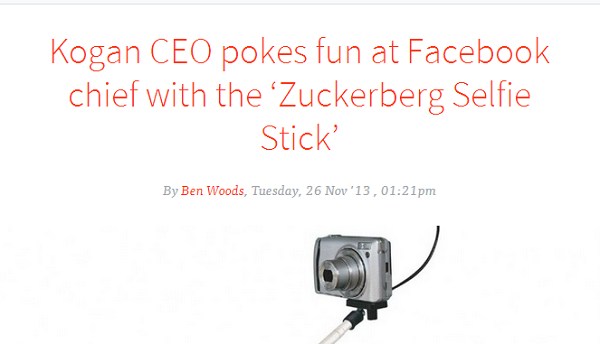
Now Kogan is not the only brand playing around with this type of strategy to gain links, PR and brand mentions. Another company Power House Fitness in the UK have also ran campaigns where they launch silly products, I have written about this company in the past on my blog to show the types of strategies they use to gain links –
So that is my tip.. build something different for your brand with an aim on generating buzz, PR and links.
Compare Backlink Data of Top Competitors With Your Own - Harris Schachter
One thing I like to do which is not only actionable but also a key first step in any campaign is to compare backlink data of top competitors with your own. Using link building tools of choice, grab the data on your competitors for your target anchor category (i.e. not a single exact match term but rather a group of variants which I call an anchor category). Put this competitive data in a spreadsheet alongside your own for the same anchor category and pivot to find sites linking to competitors but not you. If you find domains linking to more than one competitor, chances are good that you can get one too.
Get Testimonial Links - Benjamin Beck
Think of the services you appreciate and use. Check to see if they have a testimonial page that links out. If they do, offer your testimony to be added to their page. Please only give testimonials for companies that you actually use and can positively review.
Convert Non-Linking Brand Mentions Into Links - Simon Person, Zazzle Media
Right now we are getting a lot of traction tracking web mentions and then following up on non-linking brand mentions or mentions of the expertise for which our client is famous for. With some good PR follow up you can usually convert that into a 'link' and add some extra value to the piece they have written, so everyone wins.
We do this using two key tools - Social Mention and Fresh Web Explorer by Moz. We will set up a brand and 'expertise' mentions and monitor this daily to ensure our PR team can jump on it while it is still relevant and fresh in the mind of the writer.
Remain Compliant With Search Quality Guidelines - Chris Ainsworth
If you’re talking at a beginner level then my must actionable link building tip would be to ensure you remain compliant with search quality guidelines. Google especially are continually evolving their perception of links and refining guidelines accordingly; so ensuring you do not participate in schemes which breach search quality guidelines would obviously be my first point of call. Following that, I’d recommend investigating areas in which links can be acquired quickly and relatively easily. Businesses can often leverage valuable links from suppliers or partners which often get overlooked by other, arguably more advanced, techniques such as guest posting. Always start with the basics!
Improve The Strategies You’ve Used In The Past - Wiep Knol
Take a good look at your current link profile and pay close attention to both your best (as in high quality) incoming links and your most popular pages. Try to analyze *how* you got these links. Was it a specific contact, was it highly targeted content, just plain luck, or something else? Learn from your own successes, improve the strategies you’ve used in the past and try to get even better results as the last time. You don’t have to invent the wheel twice, just make sure you keep improving it.
If you’re starting from scratch, you can also take a look at the most linked-to content of your competitors for some content- or strategy inspiration. However, since you’re missing a part of the picture, fully analyzing the processes and critical success factors isn’t possible. But it can still be fun to do.
Create Quality Evergreen Content - Garrett French, Citation Labs
My tip is simple: create quality, evergreen content to pave the way for effective, meaningful outreach and the highest possible quality links.
That said, "quality content" is always a moving target and differs from vertical to vertical. Each vertical has its perennially important topics and you have to drill down into these - and investigate their linkers - to be sure that you're creating something that's going to perform well at the outreach phase.
Also complicating the "quality content" issue, the content you are capable of creating will differ if you're operating as an agency or as part of an in-house team. Inhouse you will have far more access to internal knowledge resources and will know the ins and outs of getting something published on your website. Agencies will have more trouble mining out all that internal expertise but are likely able to get content done more quickly... plus have an innate sense of what will or won't incent links.
So within my tip to create great content (yes it's a tired old tip) there lies an important, under-discussed reality. Each vertical has distinct linkers - sometimes its link list curators, sometimes news bloggers and sometimes both. Each vertical has its distinct "evergreen topics" that, if created well, will always earn links. Know your linkers. Know your vertical's key topics. Then you'll never have trouble building links.
Use Google Image Reverse Search for Image Link Buiding - Paddy Moogan, Aira
I'd recommend using Google image reverse search to look for websites that have used your images, logo or pictures of your staff on their websites but haven't linked to you. Then you can reach out to them and ask for a link because they've used your images.
Use Preciprocation To Your Link Building Campaign - Brett Snyder, Nebo
When we talk about actionable link building tips, I actually prefer to keep things simple and make sure that the tips are truly actionable for marketers regardless of experience or size of the client. That said, my most actionable tip is actually something that was written about a lot probably 3-4 years ago and that is the concept of preciprocation. You may very well be familiar with this but this can apply to any link building campaign, at any budget, in any industry. To summarize, preciprocation means identifying your desired link partners (the people you think will be interested in linking to you) and getting buy-in from those link partners before you have an asset that you're trying to get links for. This strategy can take many forms, depending on the asset. For example:
- You're running a campaign to raise awareness about an event, reach out to people who participated in similar events in the past and find out what they liked/would have done differently with those events
- You're creating a content asset, identify subject-matter experts in the field and see if they would be interested in collaborating on the asset
- You're publishing a research-focused piece, reach out to the sources you're using and ask if they have anything to add beyond what you found in their original source
The key premise here is that you want to build a relationship and offer something to these potential link partners to get them invested in your campaign. The goal here is not even to get links, it's to get them invested. Once you have someone personally invested, they are much more likely to do what you ultimately want (link to it, share it via social, etc.) but you're not simply using them to promote your asset. Everyone in SEO talks about relationship-building as the key element to link building, this preciprocation approach simply pushes that relationship-building aspect to the very front of the process and lets you stay flexible to fit your asset around that relationship (instead of the other way around).
I know this is a very long response so if you feel it adds value please feel free to edit as you see fit. If there's anything else you need from me you now have my direct email so please don't hesitate to reach out anytime.
Find What Links Your Competitors Have That Your Could Potentially Acquire - Geoff Kenyon
If you are working on promoting a new product or brand, Moz's Link Intersect is a great tool. The Competitive Link Finder is really helpful for finding what links your competitors have that you could potentially acquire. It's really easy to use too; you just put in your domain and some competitors and Moz will use their OSE data to see what links multiple competitors have and gives you a report. The Link Acquisition Assistant automates 121 different queries to help you find links - a lot of these results aren't the highest quality (such as directory sites), but you can usually find some good ones here.
Use New Products/Services/Features to Create A Healthy Link Profile - Carrie Hill, Ignitor Digital
Links now are about more than just a website linking to your website. They're about content and context. We encourage our clients to use new products, services, features, and even community events to create a healthy and sustainable link profile.
If you're a doctor, providing free flu shots to teachers in your school district, or holding a health clinic for a large company's employees can get you some good press, and some great links.
If you're a computer repair firm, work with local non-profits and churches to keep their equipment up to date and working well. Establish a great relationship and offer great service, then ask for a link from their website. You can also do this with area private or charter schools as well.
Create Stuff That Will Resonate To Your Audience - Gianluca Fiorelli, iLoveSEO
The best thing is creating stuff that will resonate with our audience and have it promoted by someone who has a clear influence on them.
In order to find the most potentially viral idea for content, I usually simulate a Facebook ads, indicate as main interest the one related to my site and analyze others interests my targeted audience have... and create the content based over the most "short-circuited" interests, using the "random affinities" principle Ian Lurie explained very well in many of his posts and speeches.
For instance, a site sell insurances and its targeted demography are interested also in Star Trek? Hence, why not creating a fake product "Starfleet Spaceships Insurance"?
Better if we are able to involve the Star Trek official website in this operation from the beginning, because they have a huge follower base and community, so that when we launch the campaign we can have the biggest social echo and, from there, earning also links but, especially, brand visibility and organic traffic.
That's the kind of tactic I suggest, and it can be replicated in almost every niche and case.
But what I care the most are not the links (well, they are obviously welcome), but the organic traffic those links may generate.
That's what I consider safe link building.
Build Relationships With Bloggers Through Guest Blogging - Miguel Salcido
Honestly, the most actionable thing that a business owner can do to gain powerful links is to guest blog. Authentically. Use a real name and face and connect with bloggers in your niche and build relationships with them. Real relationships. Invite them to post on your site too! This is also a great way to gain access to other relevant audiences. It's difficult to do for direct competitors so look to build relationships with products and services that compliment or are parallel to yours. For instance, if you run a local cleaning services company, connect with local real estate agents and local business organizations (for commercial cleaning).
Run An Analysis of Competing Websites - Daniel Law
This strategy is one of my personal favorites and all credit goes to Paddy Moogan who works at Aira.
Using Screaming Frog, run an analysis of competing websites and jot down a list of all their 404 Not Found pages. Depending on how well their website is maintained they might actually not have many 404s, but more than likely you're bound to come by a few.
Once you've compiled your list, run through the 404 Not Founds through a backlink checker. I recommend using Ahrefs as their index is updated the most frequent. Scan through the list of backlinks and drop an email to the webmasters of each domain kindly notifying them that they're linking out to a broken page. Kindly suggest another HQ and relevant piece of content (preferably your own) to take its place.
This is a great strategy in building quality links as well as assisting fellow webmasters quality control their own sites.
Personalize Outreach Emails To Generic Email Addresses - Brian Dean, Backlinko
My most actionable link building tip is to personalize outreach emails to generic email addresses.
Let me explain:
If you do a lot of email outreach you'll ultimately have to send at least some of your pitches to generic
emails (or even worse) contact forms.
Because this is the equivalent of sending your message into a black hole, many SEOs skip over these targets and move onto one where they can send a message directly to the recipient.
But to me, that's a huge mistake.
What I do is send me a message to the generic email as if it's to a specific person.
So if I know Jane runs a page or writing an article -- but can't find her email address -- I'll send a message to support@example.com like this:
Hi Jane,
Just wanted to say that I loved your latest article about X.
However, I did find a few broken links...
Yadda, yadda, yadda.
Cheers,
Brian
When you look at it from the person who reads those support@example.com emails, that's an email that he or she feels compelled to forward to Jane (in fact, it's their job to forward that message).. But sending a message that says something like "can you please forward this to the right person" is going to get deleted instantly.
Go and Make Your Website A Great Experience - Alessio Madeyski, Digital Hothouse
Go and make your website a great experience, tell a story every day, every week. Mention other websites, other companies (maybe not competitors) and then collaborate with them. Do something for someone. For example, we all need schools to suck. Why companies are not spending money (and sometimes you just need to go to a school near your HQ) to inform and do workshops with students? Like: you are a plumber. WOW! Why you don't go to schools and university teaching some tricks about plumbing?
I guess what I wanna say is: don't do anything on your website just for having links. Do it because you like it and enjoy it, and if you want links, well...they will arrive. The best time I have these days is with a tourism-related company that has a section on their website where they are telling stories mentioning museums, libraries, and spots to see. There you can contact for example the museum mentioned saying: hey, we mentioned you as a must-see during our journey to wherever!. But I'm doing it because I think it's a great idea, and the museum should be happy. If the museum is gonna give me a link back, all the better.
We need to focus a bit more on the beauty of doing things. Otherwise, everything is much more difficult.
Always Implement Strategic Planning In Your Link Building Campaign - Bill Sebald, Greenlane SEO
My best tip for link building is to schedule a block of time to sit down (possibly with your team), take inventory on what your client or business has of value (whether it’s an asset, service, or product), and think about what different types of audience could really care about it. Then think about the tactics you have at your disposal. This is where you start if you want not only links that help your SEO, but links that can send qualified traffic. I think sometimes we go in headstrong with just tactics and don’t do the required upfront work to really make each and every outreach more valuable. Basically, my most valuable link building tip is “strategic planning.”
Reverse Engineer Your Competitor’s Backlink Profiles - Rohit Palit, Techtage
My most actionable link building tip would be reverse-engineering competitors' backlink profiles. There are many backlink checkers out there, but Ahrefs pretty much blows the competition out of the water. You can never rely on a free service for a serious backlink reverse-engineering campaign, so I'd recommend at least Ahref's professional plan which costs $79/mo. It might sound a bit high, but the ROI definitely makes up for the expense.
What I tend to do with most of my campaigns is:
1. Find and identify sites within a particular niche that are performing very well in Google.
2. Explore their link profiles using Ahrefs.
3. Come up with a list of referring domains and referring pages that I might have a chance of getting a link from.
4. Do what I'm supposed to do, trying to replicate those links for my own site. For example, manual email outreach, guest post submission, relationship building, etc.
I only choose targets that I know will be very likely to link to my site because they usually link to similar ones. I make sure that my own site has content pieces that stand out from the competition, so it's a lot easier to attract links to them.
And this tactic didn't only give me a dozen cold links, I also got to know a few people with whom I still maintain a good level of professional relationship because of Ahrefs. Seriously, there are endless possibilities once you start looking through referring domains of a site on Ahrefs. It opens up a whole new world in front of your eyes. Think about a parallel (to search engines) system to find more new and interesting sites on the inter-webs.
Though it varies from campaign to campaign, I get around 25-50% success rates, so you can consider this strategy bang for both buck and time.
Leverage Guest Blogging To Build Relationships and Earn Links
I wish I could say "guest blogging" but I advocate against approaching guest blogging as a link building tactic. Guest blogging is good for building relationships and seeing links coming from that as a result, not vice versa. So I guess I don't know any "actionable" ways. I talked about that at Pubcon Vegas, so you can see my way here:
Identify Your Online Assets That Are Link Worthy - Tony Dimmock
Before hunting for links, ask yourself: “What online assets do I have (or need to create) that would be link-worthy?”
In my experience, many businesses fail before they even begin link acquisition campaigns, because they don’t take the time to understand what is “valuable” in the eyes of their website visitors and target audience.
To avoid this happening to your business, answering the questions below will reveal the “who”, “what” and “where” of your online asset strategy:
1) Who is your target demographic?
- Think about the age range, financial status, typical mindset, education and what “floats their boat”
- What are their needs, personally and professionally? Think about the problems or challenges you help them overcome
- Why do people buy from you? Asking or surveying your audience is a great way to find out what they think about you and what you offer
- What information is important to them? Finding this out will help you create content that entices them to link to (and share) your content
2) What content can you create, that doesn’t currently exist?
The opportunities to connect with your audience in your field are endless. To show your authority in your niche, could you create any of these?
- First-of-its-kind industry whitepapers that explore hot topics that no-one else approaches
- Embeddable widgets, videos or tools that solve a problem many face daily
- Real-life accounts of how existing customers used “x” to reduce “y” and gain “z”
- Competitions with prizes that entice users to share creative ways they used your products or services
- Interviews with market influencers or thought leaders that offer new perspectives or ideas
3) Where can you find influencers that will link to or share your assets?
Online and offline, try approaching these:
- Industry trade associations that your assets connect with, that provide value to their members
- Event organizers that run meet-ups where your target audience discuss topics relevant to your assets
- Journal and magazine editors who run seasonal features that your assets offer new perspectives on
- Subject-matter bloggers who research and write about topics within your niche
- Journalists who search for news, views and opinion contributors
Get Links With Partnerships - Steve Morgan
I work with quite a few small local businesses who may be long-established but are completely new to marketing themselves online. One method that I always prioritize is whether they have any accreditations or belong to any associations, as often it can be very easy to get a link and they're often authoritative websites. For example, I work with an IT support company that partnered with Microsoft (DA100), Cisco (DA98), CompTIA (DA83), Dell (DA94) and HP (DA96), some of which allow their partners to have a profile with a link. My client had done some of them but not others, so it was a no-brainer to look into doing these first.
Leverage Your Content to Build Links - Larry Kim, Wordstream
I wrote up my most actionable SEO tips as case studies, here:
We’ve used these basic strategies to get hundreds of thousands of links in the last few years, no kidding!
Don’t Ignore Broken Link Building and Link Reclamation - Steve Morgan
My most actionable link building tip is simple: don't ignore broken link building and link reclamation.
Both of these techniques are very successful, but for whatever reason, a lot of sites completely ignore them in favor of "sexier" approaches that are much less efficient.
Broken Link Building
This link building technique is typically a 3-step process:
-
- Identify pages that have broken links (i.e., links to other pages that are no longer accessible).
- Find contact information for the webmasters responsible for maintaining those pages.
- Contact those webmasters, and suggest alternative resources to replace the broken links (ideally, your page will be one of the suggested alternatives).
Not surprisingly, each of these steps can be optimized to improve the overall effectiveness of this technique. For example, you can use tools such as Ahrefs' Broken Link Feature to streamline the page identification process, and you can quickly identify contact information using tools such as BuzzStream and Pitchbox.
For even more information about effective broken link building, here are two incredible resources:
- The No Non-Sense Guide to Broken Link Building
- The Broken Link Building Bible
- 52 Broken Link Building Resources
Once you've mastered the basics of broken link building, you can improve the technique by adding one more step. Specifically, once you've identified a broken link (see step 1 above), make a note of the broken URL. Then, find all of that broken URL's backlinks, and contact the webmasters for each of those linking pages. Boom... broken link building on steroids!
Link Reclamation
This link building technique is all about taking advantage of situations where your site should already be receiving a link. These situations arise for various reasons, but the most common scenarios include the following:
-
- Unlinked brand mentions - When someone mentions your company, your employees, your social profiles, or anything else associated with your brand, it's an opportunity to secure an easy link (most people will gladly throw a link your way if they've already mentioned you).
- Broken links to your site - One of the easiest ways to lose link equity is to remove a page from your site (and not properly redirect the page's URL to an accessible resource) because it nullifies that page's backlinks.
- Improperly attributed resources - If people are referencing your site's resources (e.g., graphics, presentations, results, etc.) without properly attributing you as the creator, that is a giant link building opportunity.
To learn more about link reclamation opportunities, I encourage you to watch Ross Hudgens's video on the topic:
Do a Groupon - Andrew Shotland
I imagine several respondents went with the "do something worth linking to" or the "go for the low-hanging fruit (e.g. links from partners, etc.)" angles which I agree with completely. So I'll offer up the Purple Cow strategy in the interest of trying to make this not just another list of SEO experts advise on link building:
Do a Groupon. Groupon deals get syndicated all over the Web and create thousands of decent inbound links that really work. And if you can figure out how to run a Groupon deal for break-even or even at a small loss, you basically get the links for free. And if you can figure out how to do it at a profit, you have an amazing new source of revenue. See it here... #EasyPeazyLemonySqueezy
Take Advantage of Missing Image Attribution - AJ Kohn, Blind Five Year Old
Most actionable? I suppose that means the type of activity that is easy to perform and gets results? For me, that would mean missing image attribution.
Look at the images a client has produced and do a search by image on each one using this Chrome extension and look for sites that are using images but not providing any attribution.
Simply drop them a quick email thanking them for using the image but asking if they could provide the proper attribution. Most people are a bit red-faced to get 'caught' in this way and will quickly provide attribution.
Replicate Your Competitor’s Backlink Profile - Matthew Woodward
The one link building tactic that has stood the test of time & algorithms is replicating your competitor's backlink profile. I have written about it on my blog that will guide you through it step by step. I'll also be releasing my private SEO tool for free to my blog subscribers on the 12th of December that will help speed up the process of replicating your competitor's backlink profiles and rankings with ease.
Look At Your Network of Partners and Earn Links - Bob Jones, Visible
One of the most actionable link building tips I can give you is to look at the client's network of partners, suppliers, and manufacturers. We all know Google is about relevancy and endorsements coming from connected 3rd parties such as these are highly relevant.
Forget about the page's PageRank. Forget about the site's Alexa rank. Ignore the number of backlinks one of those sites might have (although make sure they're in a good linking neighborhood). All you need to look at is the relevancy and the relationship between the two.
Once you've listed all the applicable sites, simply reach out to them, preferably with an email address from the site you're link building for and even CC in the person in the company that might have direct contact with the other company.
Chances are you'll find a lot of willing people that are happy to place a link.
Create Valuable and Worth Sharing Content On Your Blog - Moosa Hemani, Setalks
This might sounds like a lot of work but honestly, if you have good resources to produce large amount of content within your targeted niche, this idea will not only help you gather a community around your brand (blog) but also help you get new links and targeted traffic on continuous bases.
The idea is to spend time on keyword research and extract a list of long-tail keywords that have low competition and decent search volume. You can get this list by using tools like SEMRush.com (paid) and Google Keyword Planner (Free).
Once you have the list, now create valuable and worth sharing content on your own blog and promote it accordingly. As the competition level is low, chances are most of your content pieces will easily be able to rank with little effort no off-page efforts.
I tried this with one query back in 2013 and it still ranks number 3 for this keyword and this continuously helps me get few new unique visitors and natural links each month.
Apply competitors broken link building to your website - Aleyda Solis
The most actionable tip that can be applied to any type of project: Competitors broken link building. Identify broken links going to your competitors pages (not only yours!), especially those linking to many of them. Get in touch with the linking sites by warning them about the broken link and let them know that you have a similar and updated page that they could link instead. As you're doing them a favor by warning about the broken link they will be more open to linking you ... and as this link used to go towards your competitor, you'll not only earn a link but make it harder to your competitor to re-claim it in the future.
Cause friction in your market place - Adam Connell, Blogging Wizard
My most actionable tip is to shift towards creating content that will earn links. It doesn’t have to be an infographic; it can just be a regular blog post.
Not any old blog post though.
It has to be engaging, detailed, well written and have a compelling headline.
But most of all this piece of content has to cause friction in your market place and go against the grain.
Look at what everyone else is doing, take conventional wisdom and turn it on its head.
You have to be able to back up your post in some way; you can’t just be doing this for the sake of it.
It has to be logical on some level.
A great example is a post I recently published, where I talked about “useless blog elements”.
In the post I talked about how social media widgets had no value if you cared anything about keeping traffic on your site and converting visitors into subscribers.
The post earned links from over 20 referring domains in the space of a week, including MarketingLand.com and SmallBizTrends.com.
This was all with minimal promotion and no outreach.
Create infographics on complex topics - Neil Patel
The best link building strategy I have used is to create infographics on complex topics. If you can explain something that is popular, yet complex, in a simple image, people will want to share it. On the bottom of that graphic, include an embed code and the links will roll on in. Just look at the results from the KISSmetrics infographics.
Link out generously - Cyrus Shepard
Linking out when you create content works to help your SEO and link building in 3 ways. First, it creates a psychological environment of reciprocal generosity. When influential people see you linking to them - and they will in their analytics reports - they are more likely to look at your content and marginally increases the chance of them promoting your content and once in a while, even linking to it.
Second, linking out helps search engines see your content as an "authority hub." At the risk of over-simplifying, this is a long-standing SEO concept that if your page can lead people to everywhere they want to go, then it can be considered an authority on the subject, and promoted in search results. In some cases, this leads to more traffic, and eventually more potential links.
Third, searchers see a source that links out the same way search engines do. A page with no external links in merely an essay, but a page that links out to the relevant, helpful and important resources is a page you want to bookmark and share.
The greedy SEO doesn't like linking out because they fear losing engagement if folks click an external link. The smart SEO creates such great resources she wants people to click away because she knows they will be back.
Participate in forums - Don Rhoades
I would say the most actionable link building tip I have is to answer a question your audience has that is not being addressed anywhere else online. While you can participate in forums to get sales (and you should), you can also take those frequently asked questions you find and make a piece of content that will serve as the definitive reference. An easy way to find these questions is to use FAQFox.
Reach Out to the Right People, About the Right Content - Jimmy Rodriguez
My most important link building tip isn't about what you should do, but what you should not do: don't suggest backlinks to content providers that have nothing to do with their content.
This seems obvious but comes up often at 3dcart headquarters. We post frequent articles on our eCommerce blog covering a wide variety of topics. Of course, it's all related in some way to eCommerce, but we have articles about everything from how to start a business to how to make more sales by working gift wrapping into your strategy. While it all fits under the eCommerce umbrella, these articles are clearly about different subjects that make up part of the whole, and they aren't interchangeable.
We frequently get contacted with requests to add links, and for many of them, we're happy to work something out. We love having authoritative, useful, and relevant resources brought to our attention so we can link to them. But we also get requests from people who send us links that have nothing to do with the blog post they're suggesting we add links to.
Sure, their links are eCommerce related, but the topic of the blog post they're targeting is an entirely different, specific subtopic of eCommerce that their resource doesn't immediately relate to. In order for us to link to their resource within that specific blog article, we'd have to add a new section to the article just to make the link make sense, which would result in a disorienting swerve in the content. The better solution is not to do this, so these backlink requests are refused.
When you're ready to reach out to content creators for backlinks, don't try to fit a square peg into a round hole. Just because the website's overall topic matches your resource doesn't mean any given page does. If you make a habit of mistargeting your backlink requests like this, any future requests you send out to the same content creator are even more likely to be ignored. It's easy to avoid this problem by choosing to reach out about pages that are a better match for your content. If there aren't any at all on that website or blog, create new resources that are relevant to them or simply move on.
White Hat Link Building: 4 Effective Techniques for 2019
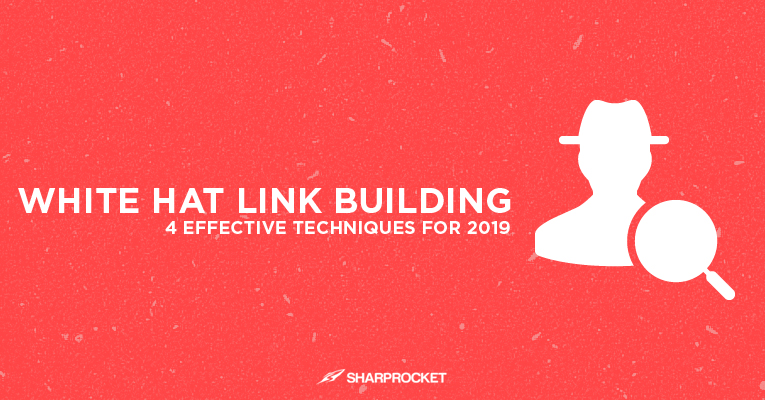
Links are important to rank for search in Google.
If you don't believe me, look at this chart:
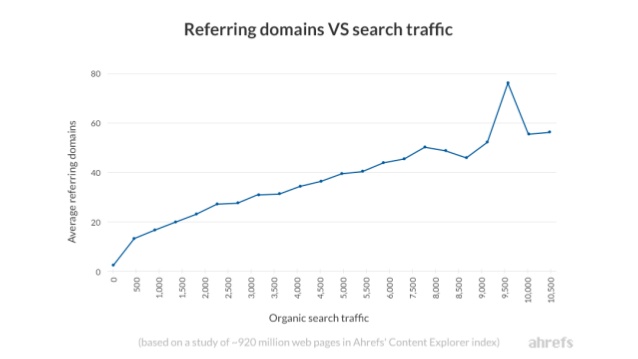
Based on the data showed by Ahrefs studying ~920 million content, the number of referring domains to a page correlates with the estimated organic search traffic to that page.
That means the more backlinks a page has, the more search traffic it gets from Google.
There is another similar correlation between the number of referring domains and the number of keywords a page ranks for.
The more backlinks a page has, the more keywords it can rank for.
Disclaimer: correlation doesn't imply causation. But those graphs provided a direct evident that links help you rank in Google.
Link building, we hear it all the time, but what does it mean?
What is Link Building?
Link building is the process of acquiring backlinks from other websites on the web with the purpose of improving traffic on search.
There are many ways to get a backlink from another site. And that's where SEOs, marketers, and business owners are constantly debating even up to this date. What should I use? White-hat, black hat, or grey-hat techniques?
Let's define what those words mean.
White Hat SEO VS Black Hat SEO
What is White-Hat SEO?
White-hat SEO refers the implementation of website optimization methodologies, strategies and tactics approved by Google. The main goal here is to provide users with the best search engine results page — user satisfaction.
If you are a white hat SEO, you follow the guidelines of Google. If you want to know all their rules, you can check out this page.

What separates white hat SEO from the rest of other types of SEOs is their ability to create high-quality content pieces that people would actively want to consume. This means putting enough effort, time, and money to craft a content asset that serves its user's search intent and content consumption needs.
The opposite of white hat SEO is black hat SEO.
What is Black-Hat SEO?
Black-hat SEO simply refers to usage of strategies, techniques, and methodologies that do not follow Google's guidelines. Marketers who are black-hat SEO still get results, but some of them may even found to be unethical in ways.
If you're a black-hat SEO, you are thinking of ways to break Google's guidelines, find loopholes, and execute strategies even up to the detriment of users.

A few techniques black-hat SEOs and link builders include deceiving users with cloaking and doorway pages, hacking other people’s websites to easily insert links back to their own websites.
Sad reality: black hat SEOs who work with clients aren't transparent about what they do, ending up sabotaging the reputation of their websites.
Doing black-hat SEO is very risky.If you're an agency, you should let your clients know about it beforehand.
Let's focus on link building alone.
Which is better? White-hat link building or black-hat link building?
White-Hat Link Building VS Black-Hat Link Building
The choice is yours.
If you are working with clients, you've got to take it seriously. You don't want to sabotage your client's sites without them knowing about what you do.
The moment you receive an inquiry from them about your services or the moment you took an initial call, that's a good time to be transparent in what you do.
Black hat link building takes a lot of risks. Link building shouldn't only concern with increasing one site's rankings, but in building a brand that's worth visiting by your users.
Remember, links pass through pages. This means that if a link isn't organically or manually acquired, you may have gotten a link but the link isn't going to pass any value to its receiving page. The value includes referral traffic and a potential sale from a customer/client (assisted conversion).
If you're working on your website, you can do a test run for yourself. You own your risk. In the majority of niches, you'll find most black-hat or grey-hat link building techniques being implemented in most sites.
Payday loans and gambling are some of the verticals where you have to play "by the rules". Otherwise, you won't have any chance of winning the search results for your target keywords.
Black-hat link building can give you initial results quickly, but some results won't last forever if they're not built solely on a good foundation. If you don't have solid content in the first place, even if you automate the link acquisition process, you're less likely to get results.
Moreover, doing black-hat SEO or black-hat link building takes a lot of investments. If you're doing Private Blog Networks, for example, you'll build several websites, publish content in them, and interlink externally to one another.
In 2017, I've conducted my own survey of the worth of investment of private blog networks.
Among 75 responses, here's what I've got.
How many websites do you have in your PBN network?
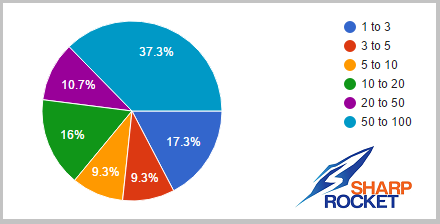
Thirty-three percent (33%) of the responses are heavily engaged in PBN, having 50 to 100 websites in their networks. A few even have a larger size of network (100 plus websites).
How much does it cost you to start each website including domain, private whois, and hosting plus a few articles to start?
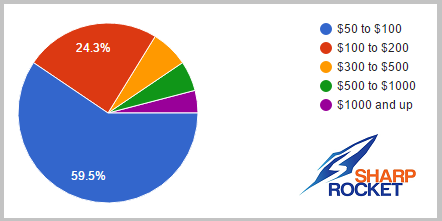
Like any website creation, you'll have to buy domains and hosting and create a few pages to get started.
With our survey results and math, the highest setup cost can range from $2500 to $10,000.
You can get that same amount and invest in your own site. Build its authority using white-hat SEO.
You'll not be reading this guide without knowing the white hat link building techniques that are still working and working effectively for websites today.
The Most Effective White-Hat Link Building Strategies
Let me start with this: there is no one white-hat link building strategy that fits all.
Every industry, every website, every backlink landscape has its own set of link building strategies (or I should say link building tactic) that will work.
However, there are sure-fire ways to get you started with link building if you want to pursue the white-hat SEO route.
SEMrush surveyed its 850 SEO and digital marketers who used their products regarding their best link building strategies that move the need of growing their backlink profile.
Let's dig into each of the top whitehat link building strategies. Are you ready?
Guest Posting
Guest posting is not dead
If guest posting is dead, why is it the most rated link building strategy? I doubt it's dead now.
Seriously, guest posting works if you know how to do it.
But first, what is guest posting?
Guest posting (also known as guest blogging) is the practice of contributing a content piece to another blog, whether that piece is an article, visual asset like an infographic, video, or any other content formats that will serve the audience of the blog (guest blog).
By all means, you can do guest posting at scale.
Whether you own one website or manage link building campaigns for several clients of your (if you're an agency), you can execute guest posting for multiple websites.
How to Do Guest Posts?
There is a process you can follow, and it starts with proper guest blog prospecting.
How to Find Guest Blogging Opportunities
Finding blogs and publishing websites suitable for your website has many different ways you can follow.
Google search
You can use the basic Google search (inurl:"write-for-us" "snoring") to find your initial set of prospects for guest blogging.
Furthermore, there are other specific guest posting search queries you can find in our search engine queries cheatsheet. But here are a few ones you can use right now:
- “KEYWORD” “become a contributor” inanchor:contact
- “KEYWORD” “contribute to this site” inanchor:contact
- “KEYWORD” inpostauthor:”guest author”
Be careful. Many blogs in every industry have "submit a guest post" pages but publish low-quality pages. They're easy to spot if you look directly at their blog section.
If you know your industry well, you know what type of content resonates the most with your niche audience.
I highly recommend using "become a contributor" as part of your search query. Given that most of the publishing sites with those contributor pages are normally looking for regular contributors and not a one-time off guest blogger, you're likely to receive repeated traffic from their blog.
You also get the benefit of bringing (absorbing) their audience from their blog to yours.
Author search
Another way to increase your list of gust blogging prospects is to identify an author who has contributed articles to different blogs in your industry.
For example, in the Internet marketing community, one that has been most active recently is Alex Tachalova of Digital Olympus.
If I want to dig in and look for available SEO and internet marketing blogs to guest post on, I'd simply do a Google search for his name, "Alex Tachalova' or even add a modifier such as, "contributor' or "guest post" — in order to give specific websites where she has written content with.
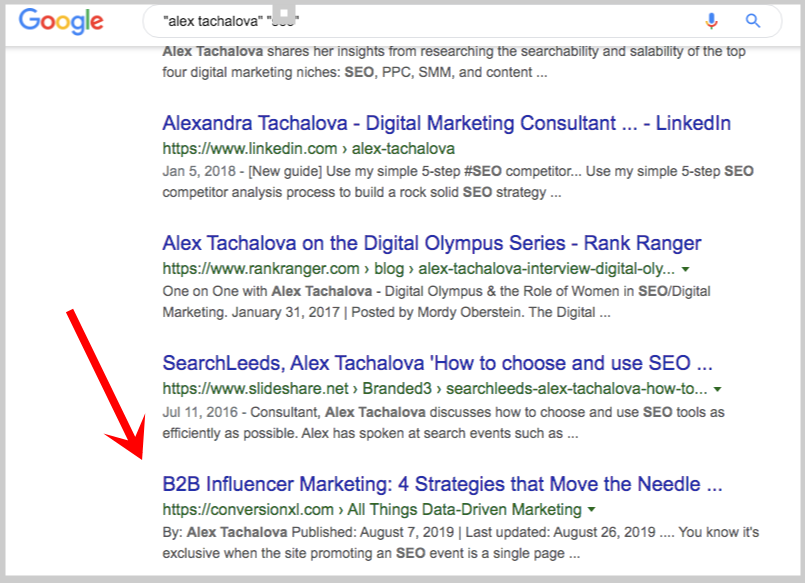
Content marketing tools
There are many different content tools that would give you quick results for any publishing sites in your niche. One that's most effective is Buzzsumo, where you can easily check for any high traffic publishing sites in your vertical.
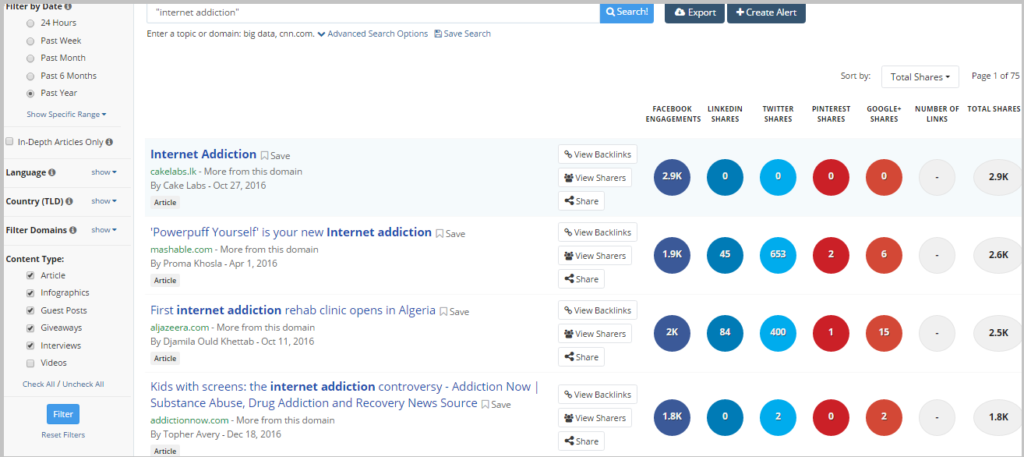
Another preferred tool is Ahrefs. Their Site Explorer has a competing domains feature that will give you more websites to prospect.
Basically, if you enter a domain URL in Site Explorer and click on competing domains, it'll show you websites directly competing with the website you've put in.
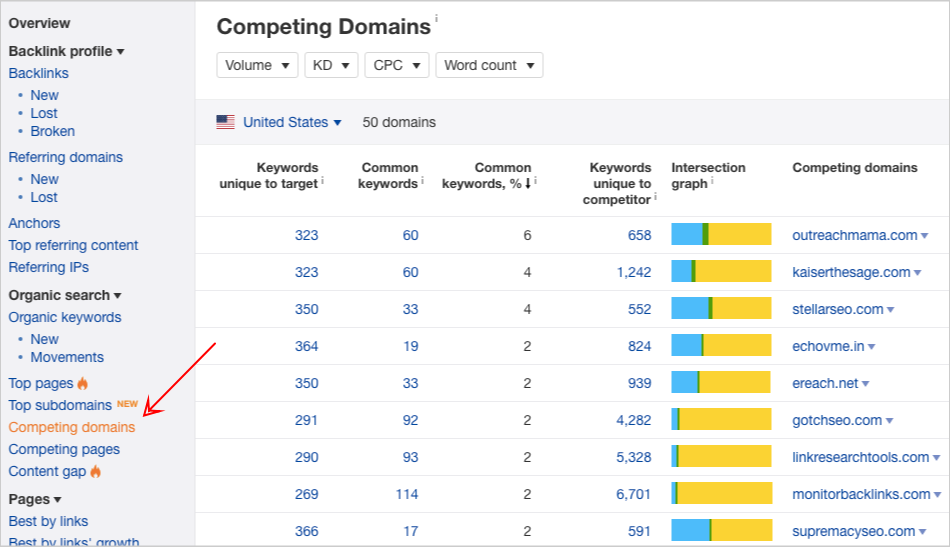
Those are websites you can also target for a guest blogging campaign.
Contact list of guest bloggers
Contacts are important to build a larger network for guest blogging. In any case, you've encountered a solo niche blogger, start building relationships through email.
You never know what that simple connection would lead you to more active lists of guest bloggers. You may ask for any possible blogs they've known or familiar with that might potentially accept guest contributions from you.
An advantage of doing this is that you'll soon discover that these blogs may not have a "become a contributor" or "write a guest post" pages, but accept contributors — if referred by someone they know.
How to Pitch For Guest Blogging Opportunity
This second step of the process may be interchangeably done with the third step (writing a guest post and publishing) depending on the list of prospect blogs you already have.
For example, there are certain guidelines in guest blogs where you have to send first a list of topic ideas write about, get approval on a chosen topic, and that's when you can start the process of creating the content.
Another process may need not to send any guest blogging topic ideas, given that you are accepted as a contributor already. They'll give you contributor access to their blog. You'll then write the post and submit it for approval.
In most cases, you'll have to pitch, introduce yourself and ask if they're still open for new guest authors.
Here's a good email template for a guest blogging pitch that you can use.
Subject: Writing for Example.com
Hey [First Name],
I’m [Your Name], and I write at [Yoursite.com]. I’m also a regular contributor at [mention a popular blog in your space].
Anyway, I’m writing to you because I have some really interesting content ideas that I strongly feel will be perfect for [Example.com]’s audience.
Optional: I’ve been following [abbreviation of their blog’s name] for quite some time now, and I have even mentioned your article about [insert topic of their past article] on this piece I’ve written [insert link to your post that links to them] a while back.
I can send you the topics I have in mind if you’re still open to new guest authors.
I appreciate the time and really looking forward to working together.
Cheers!
[Your Name]
How to Write Guest Posts
In writing a guest post, you need first to start looking at the blog's guest blogging or contributor's guidelines.
Generally, blogs that accept guest posts have their own set of rules that guest bloggers must follow before their content will be published on the blog.
Guidelines vary from industry to industry, and from the audience to the audience. They include word count, audience targeting, tone and style of writing, and additional formatting.
There are options you can choose from: do it yourself or outsource the content to a writer.
For brands, they typically have an in-house content team that crafts the guest post articles. In other online businesses, they outsource the content creation task to an outside freelancer who has expertise on the subject.
Editing, Revisions & Final Publishing
Each online business or website owner has their own sets of protocols with regards to their guest posts creation process.
Depending again on which you prefer: DIY or outsourcing — your editing, revisions, and final publishing will highly depend on it.
If it's DIY, you typically hire a proofreader or use grammar checking tools like Grammarly to improve your draft.
For businesses that have in-house content teams, their members do the tool of checking the quality of content before submitting those pieces to their prospect blogs.
For regular contributors of top authority publishing websites, what you all need to do is to submit your post and let an editor from their team do the proofreading.
How to Promote Your Guest Posts
Guest posts are meant to be promoted.
Apparently, the website you submit a guest post will use their resources (email list, social media accounts, etc..) to promote your guest post.
While that is often the case, it is always a gain to promote your guest post yourself.
Here are a few ways to promote your guest posts:
- Create an email marketing campaign promoting your latest guest post and target your email to segmented subscribers who'd find it useful.
- Share your guest posts on your own social media platforms. You may even spend a few bucks for social advertising to target fans or followers of brand you've submitted guest posts to.
- Internally link your new guest post from your existing content assets to drive visibility to it over time.
There are a lot more methods for guest post promotion, but those are a few things you can immediately apply to your blog.
How to Track Results From Guest Blogging
The goal of guest blogging is to drive results for your site. That includes new referral traffic every month, potential conversions from people clicking on links of your posts, and additional social followers which can be turned into email subscribers.
For example, I use ConvertPlug to create lead magnets for this link building blog.
For each guest post written, there are sections at the end of the posts giving away free resources relevant to the guest post in exchange for their email address.
Once guest posts are published on the blog, you can track the number of people who subscribed to your email list from those guest posts — you can configure settings of ConvertPlug to show it for you.
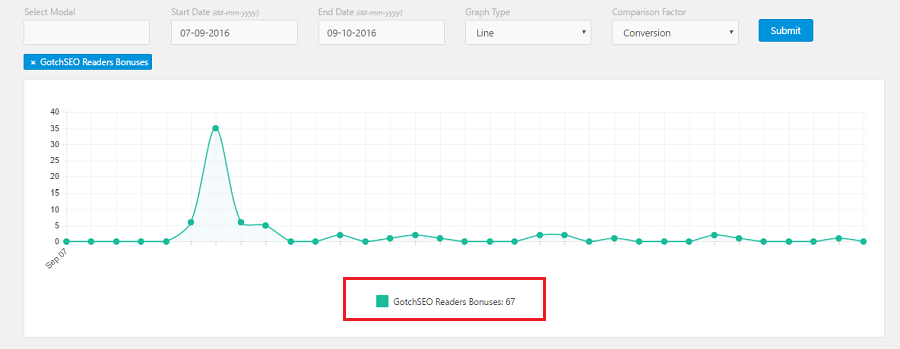
So, that's a good process you can follow for your guest posts.
If you want to know more details on each phase of the process, you can check out this definitive guide on guest blogging.
Guest Blogging Case Studies
Here are some case studies to give you evidence, inspiration, and additional insights on how to do guest posts:
- Guest Post ROI: The Data Behind 273 Guest Posts Says It’s No Good
- Guest Blogging Case Study: 5 Big Lessons From Writing 43 Guest Posts In 3 Months
Resource and Link List Pages & Broken Link Building
There are many resource pages in different verticals. These include link list pages for veterans, resource pages for students, people with disabilities (PWDs), people with Post-Traumatic Disorders (PTSD), eco-friendly enthusiasts (going green people), and many more.
Resource pages are simply pages that list down links to references on a particular topic. Some link list pages have categories to give you quick show of external resources on more specific topics.
What Is Resource Page Link Building?
Resource page link building is a link building tactic where a person contacts a webmaster and suggests recommended content assets to be added to a resource page.
What Is Broken Link Building
Broken link building is a link building tactic where a person contacts a webmaster who has a broken link in his or her website and recommends a replacement of link/s that include his/her target page.
The methodology, whether you use resource page link building or broken link building, depends if resource pages have broken links.
As simple as it sounds, you use broken link building if the resource page has broken links.
I've covered both of these methodologies here: link building for resource pages and broken link building - you may want to check these out.
Here are basic ideas of how you can start your own resource page and broken link building campaigns.
Here are simple tasks to help you build organic resource page links to your site.
1. Find a topic that serves a linkable audience
To get the most number of resource links for a page, you need to target a linkable audience or link page curators.
A link curator or a linkable audience gathers links on a specific page about a particular topic for the sole purpose of giving its intended website visitors references and resources that they can use either for personal consumption or business research.
These are types of people that are likely to give you contextual links on their resource pages. If they've found your content useful, it wouldn't be difficult for them to credit you with links for your content.
Here are some linkable audiences where your content assets can be catered to:
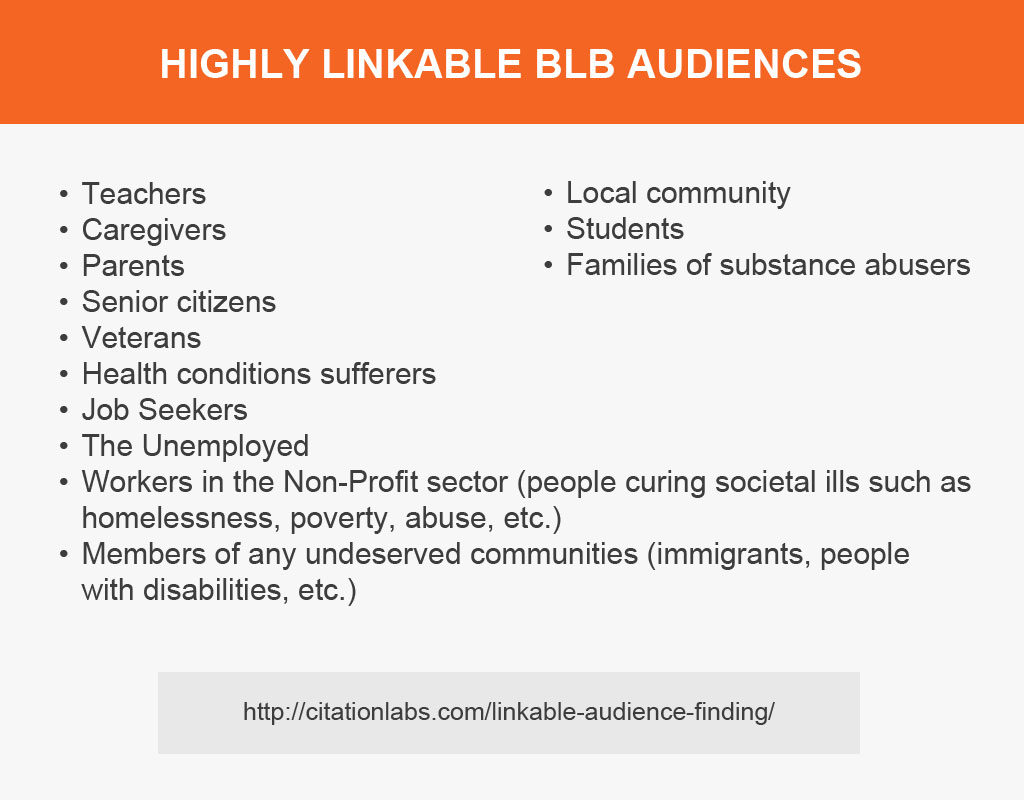
2. Create a content asset about a linkable topic
Once you've chosen your preferred linkable audience, you can now think of topics that best suit them.
For example, if you're in the sleeping industry, you'll typically have an ultimate guide to sleeping or similar versions of it. But that type of topic will not cut through the noise of many guides out there.
If you can target a linkable audience, let's say, Sleeping Guide for People With Disabilities — you'll serve a targeted audience than randomly promoting a content piece to any audience.
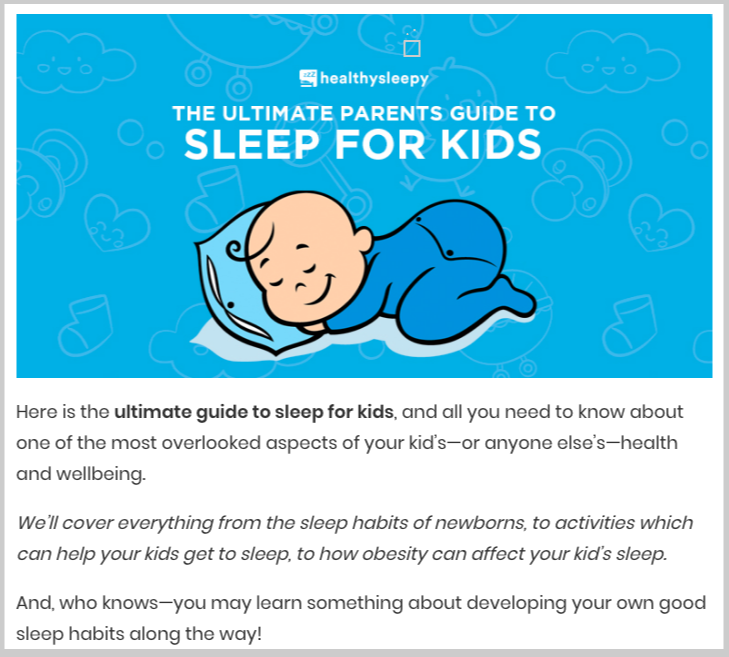
3. Discover resource pages and qualify them
There are many approaches to prospect for resource page link opportunities.
That includes using a tool by Citation Labs — Link Prospector, which helps you automate the entire process of producing relevant resource pages.
All you have to do is to enter keyphrases and configure your preferred settings, and the tool will give you a report of resource pages.

For further reading on this topic, you can see these guides on using Link Prospector and insights as to how many websites your link prospector should be looking for.
4. Find broken links and available contact information on resource pages
You can hire a virtual assistant to do this menial task for you or get a junior professional from your SEO team. Just hand them over a document that shows them the entire process of finding broken links on a resource page and of finding email addresses.
Here are two documents you can provide to your team member.
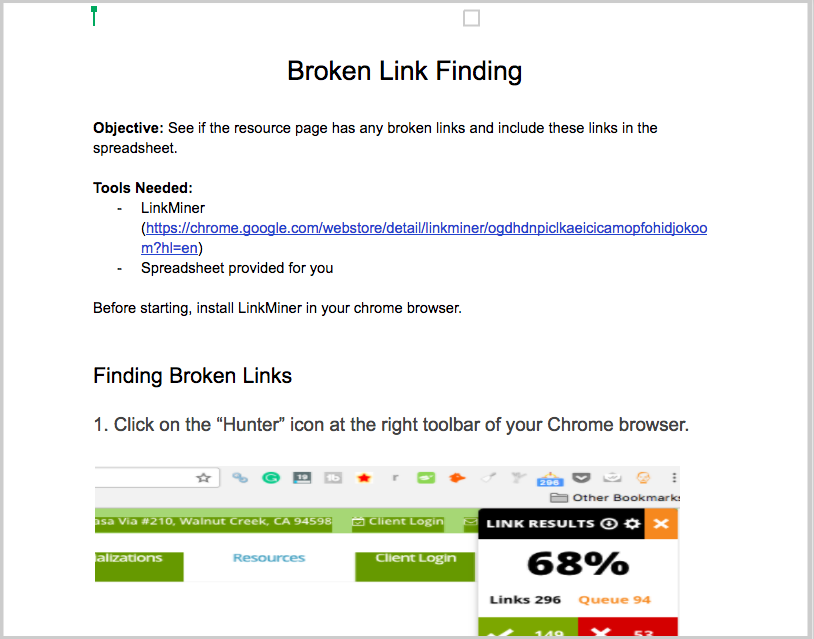
One important recommendation to organize your spreadsheet or any document to collect your link prospects is to use column footprints and/or color codes.
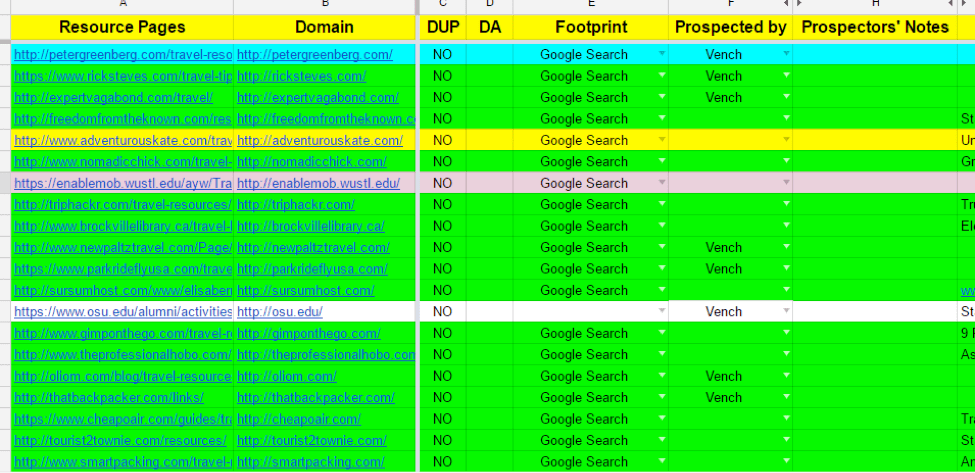
5. Send customized emails to your resource page prospects
You don't have to reinvent the wheel. If it’s your first time doing resource page link building or broken link building campaigns, you can get started with effective email templates.
Here are some email copies you can use for outreach.
Initial template without broken links:
Hi [First Name],
I was checking out some of the resources listed on the [Page Title] page of your website, and I noticed that I knew of a couple resources that might be worth adding. Would you be interested if I sent them over? If not, I totally understand, just thought it wouldn’t hurt to ask.
-[User First Name] [User Last Name]
Initial template with broken links:
Subject: Found an error on your [Resource Page Template]
Hi [First Name],
I was browsing the [Page Title] page on your site when I encountered a few broken links. I didn’t know if you’d be interested in knowing, but if you are, I’d be happy to point out which ones I stumbled across.
-[User First Name] [User Last Name]
6. Monitor new resource links
You can wait for email responses to your pitch in order to know if you received any organic links to your page/site. Another option is to track backlinks beforehand using tools like BrandMentions or Ahrefs alerts — to keep you notified through email of any new links.
[ tool to monitor links ]
Replicating Competitor's Backlinks
Doing competitor analysis is imperative in making sure you're not getting behind from your competitors.
By having that initiative, you'll get most of the benefits such as:
- Discovering opportunities you'll otherwise missed if you don't regularly check your competitors — these are keyword and link opportunities.
- Determine how much effort and resources to put in for your site on a monthly basis to cope up with the competition.
Moz recently created a superb guide on competitor SEO analysis.
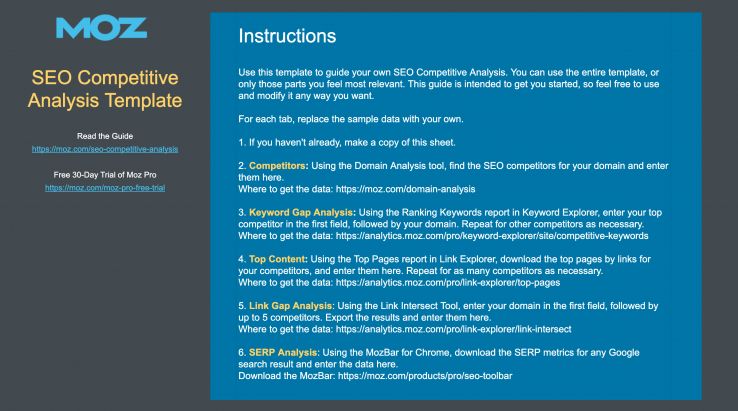
They have a template spreadsheet that you can use straight to your campaign.
Link gap analysis or competitor analysis is identifying gaps in links between your competitors and your site, understanding what strategies work in your industry, and discovering content formats that get most of the links.
You can start this competitor link analysis by entering your domain URL or (a page URL) on a link analysis tool along with URLs of your competitors.
One of the best features of Ahrefs - Link intersect can show you what pages are pointing to your competitors but haven't yet linked to yours.
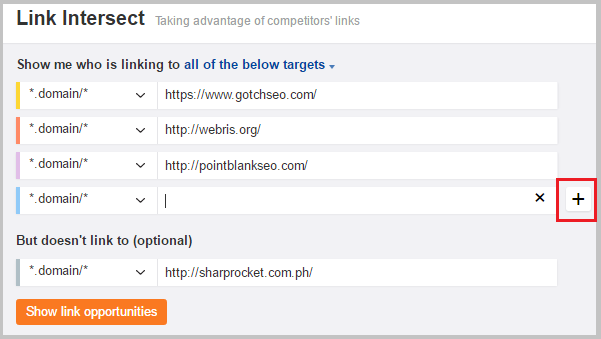
Using discovered pages that linked to your competitors, you can check if they're feasible to acquire based on your current resources.
Do you have content assets that are linkable enough to replicate competitor's backlinks?
The reality is that there are backlinks of your competitors you can't easily replicate given that they've built relationships with those linkers.
What you can do then is to analyze how they were able to get those links and replicate the strategy if you can - that's how to get competitor backlinks.
Unlinked Mentions
Lastly, there are mentions that deserve a pitch to credit them with links.
Link reclamation is the process of identifying and fixing broken links on your website and getting links from other publishers who mentioned your brand or content but didn’t link to your site.
There are many mentions of your brand that you haven't discovered yet because you were not able to track them. If you're an eCommerce site that sells a variety of products, there may be mentions of your products and other offerings that you could turn into precious links.
Start by identifying those unlinked mentions using BrandMentions or Ahrefs.
Once you've discovered them, you can proceed to pitch with a simple email copy.
Here's a good email template that you can use for link reclamation:
Subject: Thanks for mentioning [ SITE/BRAND NAME]
Hi [ NAME ],
Hope you’re doing great day.
I would like to drop a quick message to say thank you for mentioning [ BRAND NAME ] in your post – [URL].
I noticed that you hadn’t included details of our brand and was wondering if you would be kind to include a link pointing to our website, so your visitors would see more information about your reference.
Thanks again
Kind regards,
[ YOUR NAME ]
So there you have it, those are white hat link building tactics you can start implementing for your site.
Do Old Whitehat Link Building Tactics Better
You may be seeing this post again for 2020 or another year. Those old white-hat link building strategies I've shared may be too old and you may be looking for new ways to get backlinks to your site.
The thing is to be advanced in link building is to do old link building tactics better. Find ways to improve every initiative in the link building process - link prospecting, qualification, content creation, and outreach — and perform them at their high effectivity.
Creative Content Marketing and Link Building for eCommerce Websites Podcast
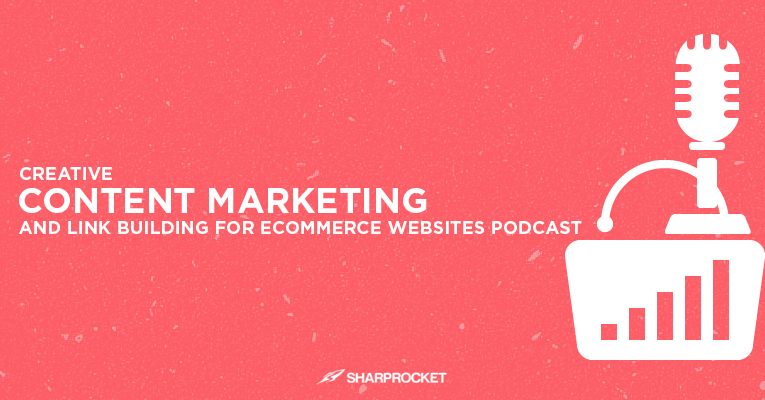
Show Agenda & Timestamps
03:55: Why don't you tell us a little bit about what is link building? And what is the best way that you see it for an e-commerce company to get started doing it?
08:26: Is this something that can really be done internally by a business owner or somebody that's in charge of their marketing? Or can it be outsourced? Or what is your take as far as getting started with link building?
11:42: In order to have content out there that's really appealing and attractive and in order for people to link to your content, what are some creative ways that you can suggest to do content marketing?
14:53: How does a company determine what's a good site to get a link on? Is there a criteria that you typically follow and what is it?
18:31: Is there a rule of thumb when it comes to the amount of links that let’s say a business should strive to get let's say on a monthly basis and how do you determine this?
Full Transcript:
ARLENE ROBINSON
Welcome back to the eCommerce Marketing Podcast everyone. I am your host, Arlene Robinson. And today we have a very special guest, Venchito Tampon, who’s the Co-Founder and Marketing Director at SharpRocket – an agency focused on quality Linkbuilding, Outreach and Strategy.
He specializes in Linkbuilding, Content Marketing, and Client Acquisition. He and his local team works with different clients of different sizes and types – small to medium brands, SEO Agencies, and Fortune 500 Companies in the US, Australia, UK, and Canada.
Welcome to the podcast, Venchito.
VENCHITO TAMPON
Thank you, Arlene, for having me. It’s a pleasure to be here and wanting to really give value to your listeners.
ARLENE
Okay, great. I appreciate it, and it’s good talking to you as well. I’m glad you’re on Linkbuilding. It’s kind of an area that I may not have delve too deep into before this podcast. So I’m really excited to talk to you about that as well as content marketing. We’ve had various takes on content marketing, but I know you’re gonna really bring some real value to the conversation as far as Linkbuilding and content marketing goals.
But before we can get into the subject of today, why don’t you tell us a little about your background? And specifically, how you got into what you’re doing today?
VENCHITO
Right, sure. I got into the online marketing industry in the year 2011. So, I became a content writer for a publishing company. So, I started from that and then been involved in the SEO industry. So, I was hired by John Cooper – one of the best Linkbuilding experts in the world. And so, he hired me to be his link prospector.
So, he got into the – all of the inaudible and the Linkbuilding - from link prospecting, outreach down to the content creation. And so, I learned about it and what I did is I started my own SEO blog. It was digitalphilippines.net. And so, from that simply just posting all of the learnings, it became inaudible you know clients in the first year.
And in 2015, I started my Linkbuilding agency with my partner Joseph, who now handles the operation side. And so, we are here in Manila, Philippines (where) we are based. We are a team of eighteen (18) linkbuilders, including all of our virtual assistants and our content writers.
ARLENE
Okay, great. That’s awesome. Well, you definitely got into the field I would say really a good time as many of our listeners know SEO, as you can probably The field I would say it really a good time as many of our listeners know SEO, and as you can probably testify to the fact that SEO has changed quite a bit and it continually will change.
And a lot of it is really spearheaded by Google and the changes that they make in their algorithm changes. All of that is really totally spawned by Google. These days link building is really - there's really a huge focus on link building more so than ever I think because not only the - is link building important, but I do believe content is also really a big, you know, it's pretty much where it's at, you know content building and Link building really kind of go hand and hand these days.
So, I think you're really on point is to where you are in your career. Now for all of the listeners out there that aren't really too familiar with the process, why don't you tell us a little bit about what is link building? And what is the best way that you see it for an e-commerce company to get started doing it?
VENCHITO
Basically, link building is a - just a discipline in marketing wherein you are based on the term, you just actually getting or earning links from other relevant websites that will inaudible whatever site that is and not just drive traffic, but also generate some assisted conversions, helping those visitors actually know more about your brand and hopefully buy your products or services.
And so, when it comes to, you know the best methodology, so I think there are a lot but I’ll just give you some of the techniques that we've been using as an Agency for most of our e-commerce clients.
Number one (1) would be to actually start with connections and partnerships because if you are a - whether you're a retailer, a manufacturer or you’re a supplier of products, you would always find our to buy pages.
So, let's say for example, you are a retailer, you can just make an inventory of all the products that you sell online and just check manually each manufacturer of those products. So simply by reaching out to those owners or those manufacturers and if you can actually see pages that are dedicated to listing down retailers, then you can actually get a link simply by doing that kind of outreach.
And so, you start with connections. You start with all of the partnerships that you had whether it's an offline or online thing. And another thing is that I've seen this with all of the eCommerce sites. There are a lot of blogs or websites that might or that have mentioned your products or brand name, but then giving you the actual length, so if you can actually track those mentions and say simply just sending them pitches and saying “Hey, we've noticed that you mention us on your blog da, da, da”, and then from that you can actually inaudible link. From that simple pitch, you can actually gain a lot of links in the first few months, if you haven't done that.
And probably one of the underrated and even forgotten methodology is the forum marketing because in 2009, I think in 2011, it's been you know, many marketers have spammed all of the forum sites, and I'm looking forum marketing from early generation perspective and I’m just trying to spam the threads with links waiting to the sites. But basically, giving value by answering questions in forums, if you look at that, it's not just getting a link but actually driving potential customer to your website. And I think those methodologies - those approaches will really help you get started with the inaudible.
ARLENE
That’s some really great advice, you know from one, the first thing that you mentioned as far as building relationships that's really kind of where it all starts as forming these relationships and you talked about what you can do is there may be a lot of companies out there that are referencing your brand or your company, but not giving you a link or maybe they're linking to an old piece of content or something that maybe is - not where you want to direct people maybe it's older landing page.
And so yeah, one thing you can definitely do is reach out to them for sure. Another thing that I mentioned to companies that I deal with and I'm actually in the process of posting a video on this because we put out a lot of SEO videos here at inaudible to help enlighten our customers and recently launched the channel actually called the e-commerce Brothers channel on YouTube and they'll be putting out a video where it talks about a little bit about what you said as far as forming these relationships.
And one thing that you can do also is to really try to get some of the heavy hitters pointing to you people that have a higher authority is you can link to them and then don't ask for anything and just start forming relationships that way just link out to them and various articles and then just let him know I linked to you this is a great piece of content. We really appreciate it. And that's one way to kind of get your - your foot in the doors.
So yeah, it's just something else wanted to add to that which I think is very useful and something that an e-commerce business can take advantage of right away. Now, I know the listeners that are out there can be a variety of businesses - a variety e-commerce businesses or people that are working for e-commerce businesses on the marketing side, and one question that I typically get with regards to any type of marketing is and specifically with link-building is, is this something that can really be done internally by a business owner or somebody that's in charge of their marketing? Or can it be outsourced? Or what is your take as far as getting started with link building?
VENCHITO
I think it really depends on the industry. If you are in a very competitive space, you might want to not just do it internally as you get all of the processes were trying to you know, hire someone or linkbuilding agencies to do that for you because the thing is when you are doing it internally, it will really require you to set up processes because sooner or later when the demand for links is increasing it will require you to just hire more members and make sure that the prospecting, the content creation, and outreach are all set up.
So, you can do it internally, but just make sure you already have some setup process documents for you to scale the entire process or the entire campaign. And inaudible, of course, for example, you can just simply you know, hire a freelance writer to do the content for you, graphic designer to create the formats and make sure the page is visually appealing to its targeted visitors and so on and so forth.
And so, there are just certain areas in linkbuilding where you can just simply outsource but make sure if you're doing it internally you have to set up processes. The thing with outsourcing is that and I always get this a lot because they're bad companies, especially link building agencies will simply just you know, send you all of the live links they've acquired for your website. And but if you look at the quality of those things it's doing more harm than good. So, if you are trying to outsource it, make sure you do some research - the quality of the links.
I really recommend e-commerce site owners to get some recommendations, and referrals is a good indicator to really check if the agency has high reputation inaudible but if it's can perfect in really give you the quality links that you're looking for.
ARLENE
That's really good. I appreciate that answer and I think one of the key things that you mentioned and I think not only internally do you need to have your own process documents, but I think for even for the outsourcing, I think that's really a key thing because I think a lot of times especially these days, see it's a lot easier these days to get freelancers and get people to do stuff remotely, but you can't just hire somebody and just expect them to run with stuff.
You have to have things documented well, otherwise, you know, it'll be frustrating not only for the remote worker, but also for yourself as far as you know hand-holding that you may have to do if you don't have your process documents in place, so that's really the main key thing, I think, no matter what.
The process has to be in play for both sides of it. Now, switching gears a little bit because I know you're really - really an expert also on content marketing. These days you do have to be creative because I think as you can probably agree on the internet is really diluted, I think you could say almost with just a ton of just content some of it a lot of it is really no good.
And so, in order to have content out there that's really appealing and attractive and in order for people to link to your content, what are some creative ways that you can suggest to do content marketing?
VENCHITO
The key is that it's not just making your, you know, infographics or visually appealing - all of those things, but really trying to identify your audience or when getting you should actually create content assets that will not just give you first or initial set of links, but can actually, in the long run, can actually help your site earn links even without doing outreach.
And so, one of the key ways is to actually create a content that's targeted to a linkable audience. So, this term linkable audience is - was coined by Garrett French of Citations Lab.
So, basically linkable audiences are groups of people or creators of pages that have their own resource pages. So, for example for the recycling or the disposal page, it's simply lists down all of the references and resources of that given topic. And so how you can actually approach your content marketing by targeting linkable audiences, simply for example, if you're selling batteries, if you're an e-commerce site that sells batteries you can actually either target inaudible or to create a content about battery recycling or if you are targeting teachers or parents, for example, you can create a guide or a research guide about battery 101 for the kids.
The thing here is that you're increasing the chances of your content to gain so much to links. And in the long run if the page is able to rank for keywords, then it will be referenced by other publishers once they find it to Google search. And so those things I think creating a content asset for a targeted audience is one thing.
Another methodology that I think will really - is very effective nowadays is creating an asset about data or statistics because this type of asset is mostly you know, reference by publishers and content creation. Our content creation teams or content creators and so the opportunity to get an inaudible rating is very high.
And the last thing is to recreate broken pages or dead pages. So, what you can do is to actually reverse engineer your competitors and see what are the pages that already given them links that have been shut down by them that you can actually recreate.
So, these are the pages that are broken, but if you look at this using a link analysis tools, you'll find out that the - these pages have gotten a lot of links. And so, when you create that content make an improved version of it, what you can do is reach out all of the blogs or sites linking to the original content and then from that process you can actually get a lot of links through that.
ARLENE
Great. As far as you mentioned, of course creating this content that's really the heart of it creating content that you want people to link to and kind of flipping it, then once you've got that content created and like you said if it is solid content people we want to link to it, but then on the other side of it is you want to get a link out there on these other sites.
And so, how does a company determine what's a good site to get a link on? Is there a criteria that you typically follow and what is it?
VENCHITO
I think the basic thing is number one, it should be the site or the blog should be relevant to yours. And I think even if it's common sense already, I think there are a lot of SEOs and link builders even marketers who (are) still trying to get links from irrelevant sites. And the key is that it's not - again, the quantity of links that you're after or looking for, but you're also trying to you know, make sure that the site or blog is relevant to your search. that's the first factor.
And the second one, I would say it's the type of links that you're getting because this type of link is something that people can click on and so they will be able to jump to your website and probably either you know, follow you or get to know more about your brand and hopefully buy your product or service. So, the thing the type of link is very crucial if you're actually executing link building campaigns.
In terms of metrics, I think it really depends. I think there are companies who are very keen into you know DA, Ahrefs DA or you know Moz, but I think one thing that's not been discussed over and over is the SEM Rush organic traffic.
So, the thing is when you're trying to get a link from a website or blog, you want to know if that site is getting is ranking for multiple keywords and it has had it happen is it will drive you consistently traffic over and over once you get a link from that.
So, I think traffic, conversions, relevance and if you can actually get a link from brand to brand, you know context, I think those things will really matter if you do you want to you know, make sure that you maximize that your efforts in linkbuilding.
ARLENE
Yeah, you're totally right. The key thing I think is the fact that it number one thing you should look at is if the site is relevant because I think really kind of on the early days of the internet and before Google was just as sophisticated as it is now as, SEOs I think we're in agencies were out there just trying to get as many links as possible on sites that weren't even relevant and that may have worked 10-15 years ago something like that. But these days the Google algorithm is really advanced. So, you know, I think back in those days, it was probably at in its infancy right now. I think Google is probably at the genius level that's already a cruise through her college.
And so, it's a big difference right now. So, you do have to be smart about what it is that you're doing and just the main thing I think to think about is - is this something that is going to is this link that I'm going to put on this site first if it was irrelevant and does it add value to the context of the actual content.
So, you want to make sure that - that is always the case and that it makes sense for the reader because you know, that's ultimately what Google says and I think that's what they really stand behind is ultimately they just want to make sure that things that are indexed give people a great experience a user - a great user experience.
And so, if you're searching for some particular keyword, whatever is returned, their whole bottom line, is that really what the person was looking for and is a good experience once they get there. So, that's the key thing there.
Now, we've talked a lot about the link building and I know that process and it's just something that I know you're doing on an ongoing basis for those businesses that are let’s say they just getting started with it. Is there a rule of thumb when it comes to the amount of links that let’s say a business should strive to get let's say on a monthly basis and how do you determine this?
VENCHITO
The answer is again, it depends, because we have experiences with clients were in you know, one client will - would like to you know, build 20 or 30 links at the maximum level. Some just wanting to you know, 4 to 6 links, but there are things that I really recommend for especially inaudible your end. So, if for example you ensure a coupon space, there are a lot of sites there are a lot of sites are actually engaging in the link building. So, they're trying to you know, get 50-60 even more links per month.
So, in that case you got to keep up with the pace of the - of the link acquisition they're doing so that would probably be your mark in a sense. But not just about the quantity, but make sure you know, you're trying to achieve a higher quality level in terms of links.
Next is the only thing at the vertical but also checking your competitors. So, you can use link analysis tools like, you know Ahrefs or even SEM Rush just to see what they’re getting. There's one – there’s one term and that is the link velocity. Basically, link velocity is the speed - the number of referring domains a site gets every month or week, whether it’s organic inaudible to outreach. There's no really good number for every site, you really have to do your own research.
Either looking at the vertical or either looking at the order of the competitors that you're trying to you know, dominate over and so yeah from those things you can actually estimate the number of ranges, let's say 10 to 20 links from one.
ARLENE
Okay, great. Yeah, that is a great advice there and I'd appreciate your honesty and that it's really hard to tell, but yeah, I think every business or industry is going to be a little bit different and it does really depend on the particular vertical a year in and what your end goal is with its link building. And so, that totally makes sense.
Well then, Venchito, I really appreciate you coming on here today for this episode of the e-commerce marketing podcast. You've definitely been very insightful with regards to the link building on that you're doing day in and day out as well as you know content marketing.
And at this point, I like to always close things out with just one other quick question that I kind of switch gears. It's my closing fun fact, so we learn a little bit more about you. What is one fun fact that our audience would be surprised to know about you?
VENCHITO
Fun fact, I think I don't know how to ride a bicycle or motorcycle.
ARLENE
Okay. Okay. That is an interesting fact. Okay, so you don't - don't know how to ride a bicycle. Well, I don't know how to ride a motorcycle myself. So, I think I can join you on that one. But do know how to ride a bike ride a bicycle and you guessed it really is never too late to learn. So yeah, definitely something I encourage you to do. I do hope I can occasionally here in the Orlando Florida area where I live in yeah, it's a great - great exercise and it's good to get to get out on a bike.
VENCHITO
Yeah.
ARLENE
Okay, great. Venchito, well finally, if our listeners would like to pick your brains anymore regarding link building a content marketing, what is the best way for them to get in touch with you?
VENCHITO
Sure, they can visit my website at www.sharprocket.com.ph that is S-H-A-R-P-R-O-C-K-E-T.com.ph or you can send me an email at venchitotampon@gmail.com that is V-E-N-C-H-I-T-O-T-A-M-P-O-N@gmail.com. And send any questions if you really want to, you know learn about linkbuilding, (or) if you want to invite me to speak at your event or even in your podcast. But I want to make sure - I really want to make sure we'll give you some more value to your listeners margins. Yeah, that's it.
ARLENE
Okay, great, Venchito. We appreciate that and I know our listeners will take advantage of that and reach out to you as well. And once again, thank you for joining us today on the e-commerce marketing podcast.
VENCHITO
Sure, thanks for having me, Arlene.
Content Strategies for Organic Growth
You've heard a couple times that content is king, yet most people still don't quite understand how to execute content strategies with the aim of growing their site's organic traffic.
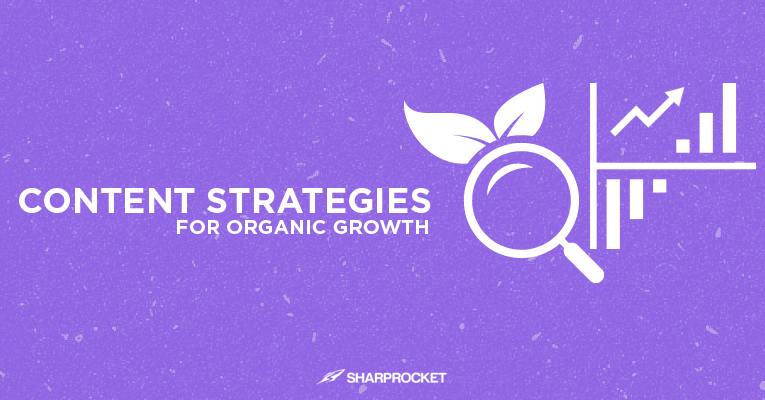
It's not easy to come by with a few techniques you can easily implement that guarantees results, if fits right to your site and to your industry.
Proper execution is a key to growing what you already have.
So before you close this page, here are four techniques that are not just trendy, but very actionable for your site of any type.
LEVERAGE DEFINITION OF TERMS AND ABBREVIATIONS
Your industry has a lot of terms. You can't assume all your readers know about. The number of industry terms depends on industry AND how technical practitioners are in your field. If there are more professionals paving their way to create their own jargons and popularizing these, it would mean more opportunities for this type of content.
Create your own short-form content that defines industry terms.
You may already know if you're a content marketer, but more than looking for exact phrases or terms people in your vertical uses.
Seek for any terms that are used in different contexts for different industries. A good example of these are abbreviations. The abbreviation, MOV, has individual meanings for many contexts: business, physical education, medical, construction, and even games.
- definition of mov
- mov definition
- mov meaning
- mov stands for
- what does mov stand for
- what does mov mean
Go even further than just publishing a page with meta titles: definition of ___ or meaning of ____. Know which other connected words have higher search volumes than the latter two phrases (definition and meaning).
You can discover keywords definition-pages are ranking for by entering the URL of the top pages ranking for the keyphrase you're targeting - "definition of ___".
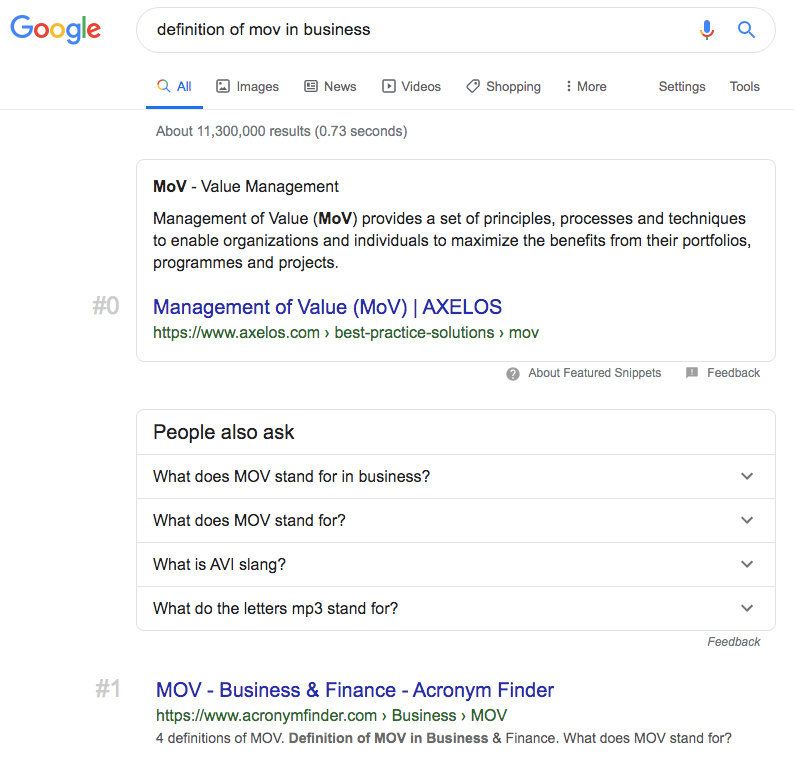
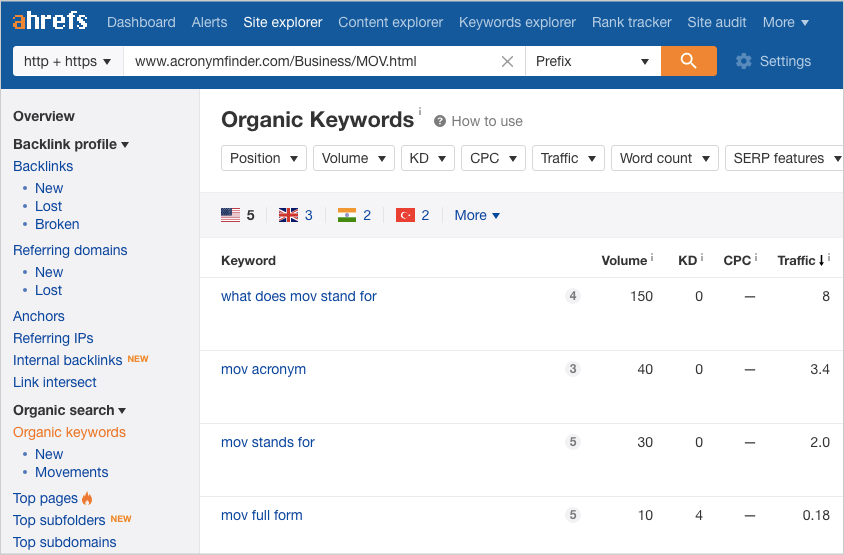
You'll see keyphrases you can incorporate to your page to make it also rank for them. You get more ranking opportunities in doing so.
PILLAR CONTENT STRATEGY
Creating pillar pages based on topic clusters as part of your content marketing campaign is imperative in building the authority of your site given that search engines use relevance and today's authority to determine if the site or page is worth ranking for certain keywords.
A pillar page is the basis on which a topic cluster is built. A pillar page covers all aspects of the topic on a single page, with room for more in-depth reporting in more detailed cluster blog posts that hyperlink back to the pillar page.
In order to create pillar pages, you need first to understand topic clustering.
A few of the benefits of creating pil:
- Increases potential to rank for higher volume keywords, even higher value as a single pillar page is populated with smaller clusters that can cast a wider breadth to a certain topic.
- Establishes semantic relationships between pages' content and other overacrhing pillar pages (clustered pages).
- Benefits the internal linking structure of the site as it leads people through links of pages — making them efficiently go through your brand's buyer journey.
- Earn organic links by ranking for terms mostly referenced by publishers.
Get started with this by looking for parent keywords - certain topics that cover the broader part of subject and that comprise different keywords attached to it.

Depending on your industry, dig deeper into certain niche topics your brand only cares about. Don't try to include irrelevant parent topics, but as much as possible, look for the parent topic of your chosen keyword. You can easily do that using Ahrefs.
DISCOVER EMERGING KEYWORDS
Search landscape evolves as more and more people are doing their searches differently based on their needs and their contexts.
New emerging keywords are popping out in every industry that particularly addresses informational and even purchasing needs of the audience.
By taking advantage of emerging keywords (normally as part of your keyword research process for blog's content creation), you will reap a number of benefits including:
- Getting initial rankings for low search volume, yet to potential to rise as demands get high
- Reaching new ranking opportunities by helping your existing content assets rank for new terms
- Increasing click-through-rates for your existing assets by adding related words that matches their new intent.
- Acquire contextual links by ranking early for emerging keywords on search results.
How do you find these new keywords?
There are two ways you can utilize for your content marketing campaign.
The first one is by using Ahrefs as a tool to semi-automate discovery of emerging keywords. Its Keyword Explorer has a feature that filters keyword search results based on NEWLY DISCOVERED.
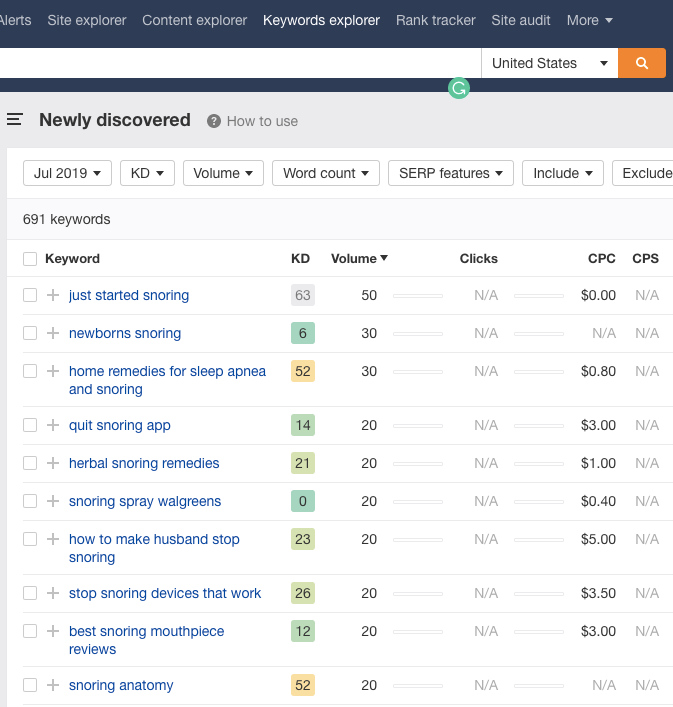
Another method is to use Search Console in order to discover emerging keywords your pages have been visible on search results.
With these new keywords, you can execute useful initiatives, such as:
- Improving your content depth by including topics from emerging keywords you may have discovered.
- Using emerging keywords as thematically-related anchor texts in your posts linking to other related pages in your site.
DEVELOPING YOUR KEEN EYE FOR ORGANIC GROWTH OPPORTUNITIES
There are many opportunities to develop your content to match to new emerging opportunities in order to increase in organic traffic from channels like search and social.
Audit your existing content assets and research well on your industry landscape. Through observation, planning, and execution, you'll never run out of ideas that can be of useful to accelerate your content strategy.
Guest Posting Ideas At Scale
You are tasked to build hundreds of guest post links. The first challenging initiative to hit the numbers is to find relevant guest post ideas. So, what scalable process can you follow to get guest blogging topics?
The reality is you can't send massive emails to your guest blog prospects and just propose them with a list of generic topics they can choose from.
That's a key to immediate failure, for sure. First, you are providing guest post ideas that don't match to their website's topic theme (topics they don't really cover on their blog). Second, your topics may not be giving any value to their audience — reason being, you don't even check who their blogs cater to.
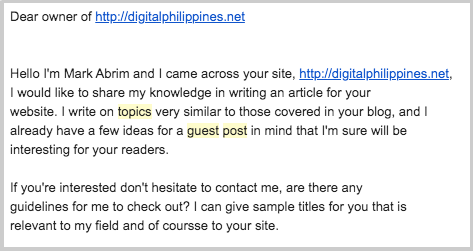
Answering this question:
Hi guys
Need some advice from guys who build Guest post links,
I am building 120-150 links a month, and sometimes it is confusing when it comes choosing guest post topics, Do you guys follow any process to get Guest post topic ideas on scale?

Let's face it. You can't hit and miss in finding blog topics for your guest posting sites. Otherwise, you'll be wasting the time you spent in discovering those sites — especially if you don't get any results from your pitches.
AUTOMATED TOPIC IDEATION PROCESSES GONE WRONG
I've seen several articles discussing how to use a tool to generate hundreds of topic ideas in 5 minutes. While that may be a good choice, people are risking blog titles that are brand-off, or even niche irrelevant if they do that.
Take a look at this example. This is a blog that covers sleeping for a highly targeted audience - sleeping enthusiasts and people who suffer from sleep deprivation, and sleep problems and illnesses. If you push topics outside of sleeping and snoring to that site, you won't get much success.
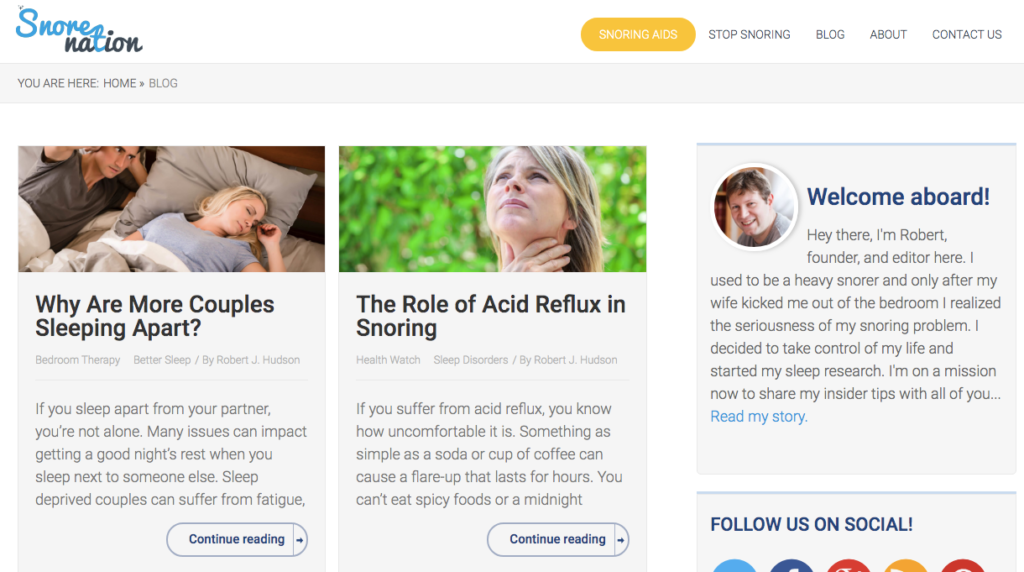
Meanwhile, a general psychology site like Psychology Today can cover sub-niches under its main blog theme. You see, you can't just make a list of 10 topics and submit it to two different websites with different audience targeting.
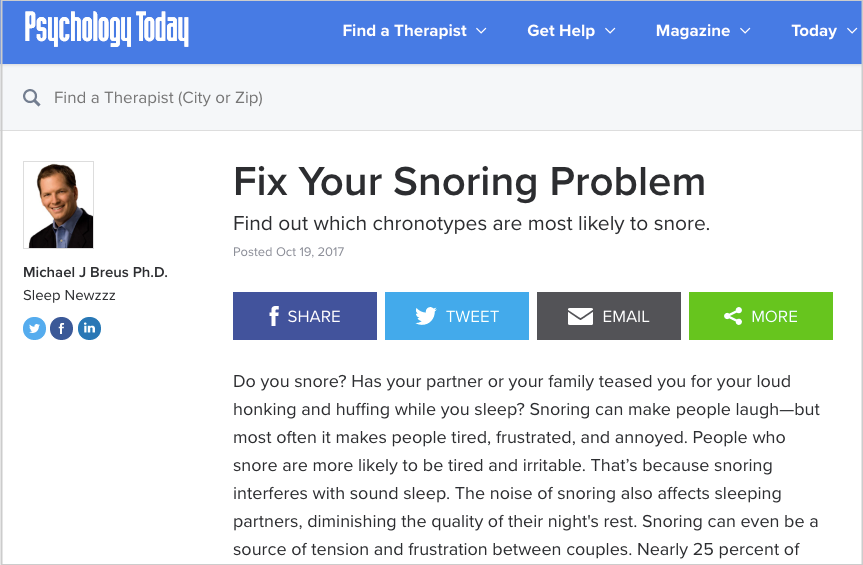
NICHE-BASED GUEST BLOGGING IDEATION
Niche-based topic ideation for guest blogging campaigns is okay as long as websites you target for guest posting covers the same audience and have the same topic themes for their blogs.
The best way to solve the problem of overlapping topics for different niches is to categorize your guest blog prospects based on their verticals and topic themes they cover.
This approach can help you ensure you don't hit and miss your approach to pitching your ideas for publishing websites.
5-MINUTE PERSONALIZED GUEST BLOGGING TOPIC IDEATION
The best and still the recommend methodology to get the highest approval rate for guest blog topics and highest content placement rate is to personalize your topic ideas individually to your target publishers.
You can't shortcut topic ideation.
However, if you're doing it at scale, the more you execute the process, the more your content writers or content specialists will now be able to shorten the time spent on it, as they become familiar with each step.
A. CONTENT GAP ANALYSIS
Content gap analysis is finding keyphrases your competitors are ranking on search results and have covered on their blogs - which your blog can potentially publish too.
It's a great value when doing guest blogging, as you are pitching a topic that has the likelihood of bringing in new traffic to their site.
You can start this topic ideation by using Ahrefs. It has a feature that does content gap analysis. Enter the URLs of two or more websites.
The question here is, how can you find your guest blog's competitors blogs?
Do a Google search with related advanced search operator to find related websites of your guest blog prospect.
[ related google ]
Then choose among the sites on the search results and enter their URLs to Ahrefs' Content Gap feature.
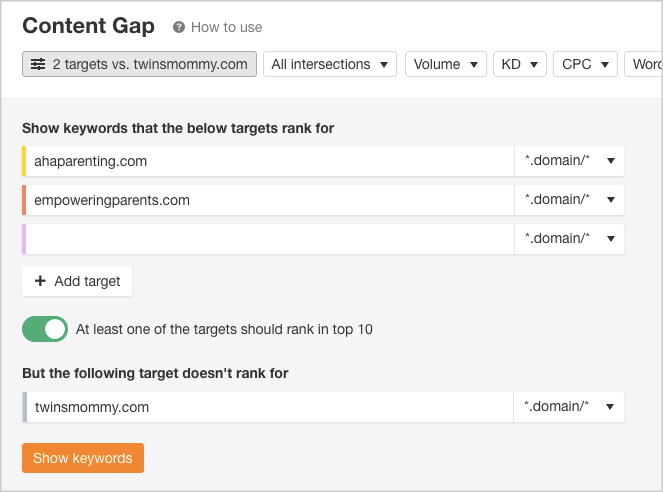
Ahrefs will show keywords your entered sites have been ranking in at least top 10, but your guest blog target doesn't rank for.
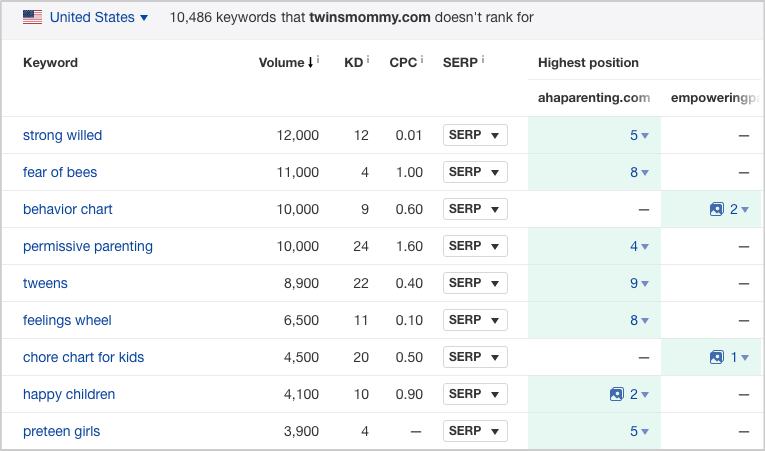
You can create topics out of those keyphrases and include it in your individual pitch as one of your proposed guest blogging ideas to write about.
B. HIGH SEARCHED DEMAND PAGES FROM RELATED SITES
Besides content gap analysis, you can also discover on-demand topics based on their estimated monthly traffic.
To get around this, head over to Ahrefs' Site Explorer and enter one competitor's URL or related site's URL.
Go to "Top Pages" reportwhere you'll see the list of all of its top webpages, which you can sort by estimated organic traffic.
By doing so, you can find out which topics gets lots of searches every month. You can emphasize the value of the topics in your guest post pitch, by stating its estimated organic traffic potential. This means that the guest blog can benefit from the post once it ranks potentially for the keyphrase it targets.
C. ON-DEMAND INDUSTRY TOPICS
If you have topic themes for niches you're pursuing in your guest blogging campaign, you can head straight to Ahrefs' Content Explorer.
Simply search for a topic in Ahrefs' Content Explorer. It will give you the top and recent pages for the topic of your choice.
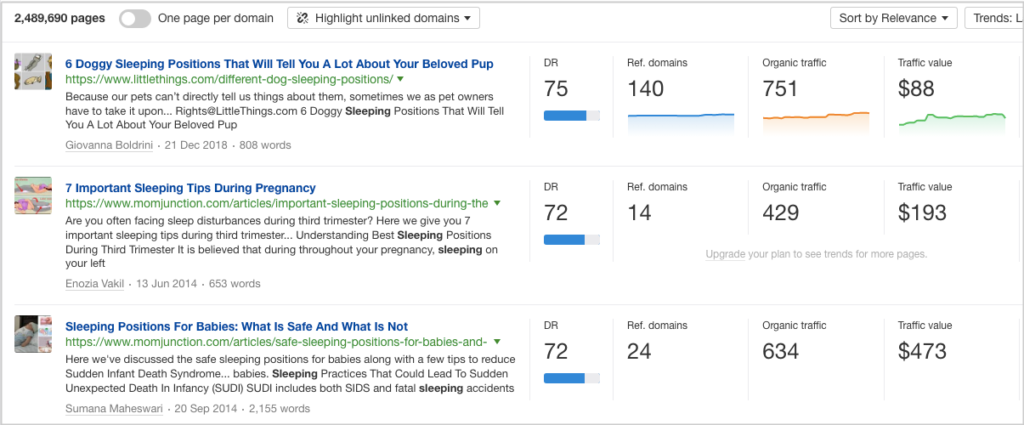
There are three value propositions here.
Referring Domains
You'll find pages (with topics) that have acquired contextual links from other sites. Though links may have been built because of overall site factors, like its overall domain authority, still you'll get an idea that the topic of the page is likely to be linkable.
By pushing this out in your pitch that a topic is linkable based on the data. This would give you a higher likelihood of a topic being accepted by the publisher.
Organic Traffic
Next to referring domains is the organic traffic the page gets on a monthly basis. Here, you'll see if the topic itself has a declining or upward traffic. Avoid topics with declining traffic, and choose ones with upward or steady organic traffic.
Traffic Value
While not all topics have high traffic value, given they're not commercial in nature, you may still find topics that have a good number of traffic value. It's a good unique proposition in your pitch, knowing that if the topic has been covered, it has a potential to drive not just traffic to the site, but also bottom of the line numbers like assisted conversions.
FURTHER READING:
4 Intermediate Tips to Improve Guestographics
SCALING IS SIMPLE WHEN PROCESSES ARE PLACED
Every phase of a link building campaign should have processes in place, ready for execution. So if you want to scale your topic ideation for guest blogging, start documenting your process either using a document platform or Google document. It saves you time when hiring content writers who can do the same process of finding guest blogging ideas fit for your target sites.
